IMPORTANT VOICES AMAZ NG BU LDINGS THE ARCHITECTURE OF BOSTON YOU NEED (OR MIGHT WANT) TO KN W THE TOP 100 CITIES IN THE U.S. TR E DAT ARTCH TECTURE AS A DEMOCRACY – THE U.S. SINKS TO A NEW LOW EGAL VIEW I FEEL LIKE AN IDIOM THE 2021 PRITZKER AWARD EXPRESS YOURSELF THE LIGHTER SIDE OF THE PANDEMIC COMMERCIAL CONSTRUCTION LENDING THE ARCHITECTURE OF MELBOURNE REAL ESTATE F THE FU URE PROFILES OF SURV VAL ONE VANDERBILT


MAY/JUNE 2021 / VOL 29 / ISSUE 3 $8.50
The VOICE OF REAL ESTATE IN TEXAS

Give yourself the gift of smiles. J
A handsome, artbook-style volume with the best Diversions to appear in over the last decade. A compendium you will treasure for years to come.
"This collection is laugh-out-loud funny!" Kirkland Review of Books

"Prescription: Read 3-4 pages a day for a month. It’ll brighten your day! And make it last a month."
"This is simply genius. I kept on laughing the whole day when I read it."
Maria Tariq
"...absolutely hilarious! I laughed so hard that it brought tears to my eyes."
Randal Maynard



Additional recommended reading
"Incisive yet expansive - as if the psychology of R.D. Laing encountered the self-exploration of Hugh Prather to help readers delve into their own thought, experiences and behaviours."

The Rockford Tribune










"Curiously intense and ironic. This is a work that will make you think and feel and you will revisit it over and over.Marion Danziger, The Toronto Town Crier
All available at Amazon, BarnesAndNoble and in the Apple Book Store (search by title).

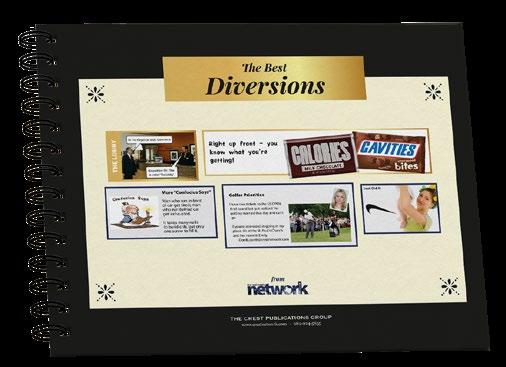
A Compilation of Sarcasm, Word Play, and Witticisms from the pages of .
Susan Carnegie, The Montreal Voice
from the pages of
10
THE BLUEPRINT
THE TOP 100 CITIES IN THE U.S. TO LIVE, WORK AND VISIT
Resonance Consultancy ranked American cities by using a combination of statistical performance and qualitative evaluations.

20
THE GREENEST COUNTRIES IN THE WORLD
Courtesy of the Visual Capitalist, a graphic view of who’s the greenest of them all.
22
THE BUILDINGS OF HOUSTON

A pictorial look at the towers of Texas’s largest city.
24
EXPRESS YOURSELF

26
THE ARCHITECTURE OF MELBOURNE
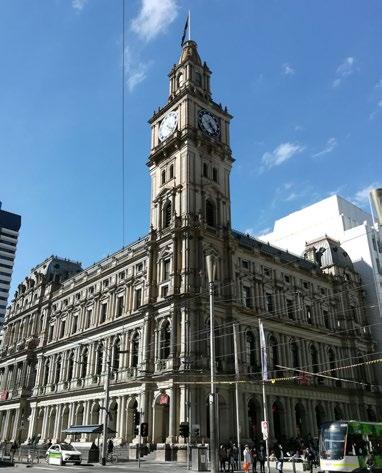
A pictorial look at the second largest city in the land down under.
42
FEATURES
IMPORTANT VOICES –RACIAL EQUITY
Alan Berube and Sarah Crump of the Brookings Institution examine the inclusivity of metropolitan areas over the last decade.
46
PROFILES OF SURV VAL
Contributing Editor Roxana Tofan’s series of success stories in the time of coronavirus – this time Margaret Martinez of the Clear Integrity Group.
47
Michael Dukakis, Gina Lollobrigida, Olga Korbut, Joan Baez, Lance Ito.
48
Contributing Editor Rose-Mary Rumbley looks at titans of retail – John Wannamaker, R.H. Macy and Herbert Marcus and his sister Carrie Neiman.
28
REAL ESTATE F THE FU URE Floating houses in the New Kiribati.

30
THE TOBY AWARDS
A pictorial tribute to the winners of BOMA’s Southwest Regional competition.
32
AMAZ NG BU LDINGS –CORRECTING THE RECORD: NEW YORK GETS A NEW GATEWAY
Contributing Editor Angela O’Byrne looks at the revitalization of Penn Station in New York City.
THE U.S. SINKS TO A NEW LOW AMONG THE WORLD’S DEMOCRACIES
Freedom House assesses and compares the real-world rights and freedoms enjoyed by individuals in democratic countries around the globe.
38
THE 2021 PRITZKER ARCHITECTURE PRIZE
Anne Lacaton and Jean-Philippe Vassal of France were named as the newest laureates.
41
Jesse Weissberg of Bild talks about conventional and new financing options.
49
THE PAGE Hannibal Hamlin (Lincoln’s first vice-president); the Wilmot Proviso.
50 34
EGAL VIEW – THE POWER OF EMINENT DOMAIN
Attorney and Contributing Editor Anthony Barbieri looks at what happens when property is condemned.
52
ARTCH TECTURE
Chuck Pinson’s dramatic landscapes are the art of inspiration.
PROFIL C VID-19 GOING GR N
/ THE NETWORK / MAY/JUNE 2021 - 4 -
The English language has the most words of any language, but sometimes only a phrase in another language can really express it. 10 22 25 26 28
CONSTRUCTION CONTRACTORS




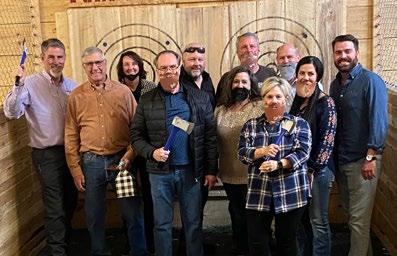
/ THE NETWORK / MAY/JUNE 2021 - 5IN THE N WS BACK PAGE –Our Advertisers / Contest Winners / Answers / Coming Next Issue IREM FORT WORTH CREW FORT WORTH BOMA TEXAS SIOR Editor’s note INB X | ON THE COVER IREM HOUSTON MASTHEAD | OUR AFFILIATES YOU NEED (OR MIGHT WANT) TO KN W The ‘V’ Sign, Battery Power | Algorithms THE TRU T FOR PUBLIC LAND – SAN ANTONIO THE RES URCE PAGE ONE VANDERBILT SHANGHAI TOWER SUNRISE KEMPINSKI HOTEL TURNING TORSO PROFESSIONALS ON THE IBC C NTEST – WHAT KIND OF LEADER DOES THAT COUNTRY HAVE, BWANA? CONTRIBUTING WRITERS YOU NEED (OR MIGHT WANT) TO KN W American Football TR E DAT – MISCELLANEOUS LINK : MARKET PLACE AND DIRECTORY 55 62 18 19 30 19 08 09 18 06 12 58 54 17 18 40 44 56 57 63 07 13 16 60 DEPARTMENTS AFFILI TE NEWS THE FACTOR Background vector created by archjoe - www.freepik.com 33 40 44 31 19 I FEEL LIKE AN IDIOM - QUIZ
HUMAN RESOURCES TERRIBLE TRUTHS REDNECK SAT ANSWERS THE LIGHTER SIDE OF THE PANDEMIC – PART 9 25 25 37 51 MORE ACTUAL HEADLINES I HATE MEN – Q & A MY IP ADDRESS 54 55 60
DIVERSI NS
CHECK US OUT ON
ABOUT US
Now in our 29th year, reaches over 50,000 Texas real estate professionals bimonthly, and an additional 50,000 throughout the U.S. via social media! We proudly serve and service any and all real estate associations in the state of Texas - including (but not limited to) the ones you see here. If your group isn’t shown and you’d like for us to include pictures, information and event-coverage, please let us know. Email: editor@crestnetwork.com or call the number above.

EXECUTIVE STAFF
ANDREW A. FELDER: Publisher/Managing Editor. aafelder@crestpublicationsgroup.com
XENIA MONTERO: Associate Editor and Art Director. xeniam.design@gmail.com
ANNETTE LAWLESS: Social Media Manager. annettelawless@hotmail.com
MARK ANGLE: Director of Business Development. mark@crestnetwork.com


CONTRIBUTING EDITORS
ANGELA O’BYRNE, AIA: Amazing Buildings.
ROSE-MARY RUMBLEY: Herstory.
ANTHONY BARBIERI: Legal.
JULIE BRAND LYNCH: Professionals on the Move.
ROXANA TOFAN: Profiles of Survival.
ADVISORY BOARD
ANDY GABEHART: President & CEO of Office Interiors Group, 247Workspace.com, United Electronics Recycling.
KIM GHEZ: Director of Marketing, Presidio Title.
KRISTIN HIETT, CAE: Executive Director/CEO – IREM Dallas Chapter.



KIM HOPKINS: Executive Director, CREW Dallas.
JONATHAN KRAATZ: Executive Director, USGBC Texas Chapter.
MYCHELE LORD: CEO, Lord Green Strategies.

DOUG MCMURRY: Executive Vice President, San Antonio AGC.



LAURA MCDONALD STEWART, RID, FASID, ILDA LEED AP:
Editor of PLINTH and CHINTZ, an interior design blog.

JESSICA WARRIOR: Director of Property Management, Granite Properties.



STAFF, EDITORS & ADVISORY BOARD
Get the app!
(Search: Crest Network)


AFFILIATE ASSOCIATIONS

...truly a brighter, lighter side of real estate. Marti C. (Freehold, NJ)
A cover to cover gem!
Mike F. (Arlington, TX)
You can’t go anywhere without seeing a copy of .
Chad R. (Fort Worth, TX)
...entertaining and informative. Carla C. (New Braunfels, TX)




the accuracy, subject matter, quality or timeliness of any Content. Change of address: Mail to address above or email editor@crestpublicationsgroup.com

/ THE NETWORK / MAY/JUNE 2021 - 6MAY/JUNE 2021 / VOL 29 / ISSUE 3 A publication of CREST Publications Group 2537 Lubbock Avenue, Fort Worth, TX 76109 Tel: 682.224.5855 Fax: 817-924-7116 www.crestnetwork.com
@NetworkMag1 /TheNetworkTexas @Networkmag1 Copyright ©2021 The CREST Publications Group, 2537 Lubbock Avenue Fort Worth, TX 76109. All rights reserved. All information contained herein (including, but not limited to, articles, opinions, reviews, text, photographs, images, illustrations, trademarks, service marks and the like (collectively the “Content”) is protected by copyright and other intellectual property laws. The Content is the property of The CREST Publications Group and/or third party licensors. You may not modify, publish, transmit, transfer, sell, reproduce, create derivative work from, distribute, republish,
display, or in any way commercially exploit any of the Content or infringe upon trademarks or service marks contained in such Content. GENERAL DISCLAIMER AND LIMITATION OF LIABILITY: magazine contains facts, views, opinions, statements and recommendations of third party individuals and organizations. The publisher does not represent or endorse the accuracy or reliability of any advice, opinion, statement or other information displayed and any reliance upon same shall be at the viewer’s sole risk. The publisher makes no guarantees or representations as to, and shall have no liability for, any content delivered by any third party, including, without limitation,
Laura McDonald
Andy Gabehart. Kim Ghez. Kristin Hiett. Kim Hopkins. Jonathan Kraatz. Mychele Lord. Doug McMurry. Stewart. Jessica Warrior.
Rose-Mary Anthony Julie Brand
Andrew A. Felder. Xenia Montero. Annette Lawless. Mark Angle. Angela O’Byrne. Rumbley. Barbieri. Lynch. Roxana Tofan.
Our Digital Edition is an exact replica of the printed magazine, only better! Browse, save articles, or even check the archives for something you want to read again!

CONTRIBUTING WRITERS
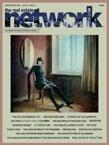
ANTHONY BARBIERI (P. 50) is a shareholder at Kessler Collins, where he enjoys a broad legal practice. He has been a speaker for ICSC, IREM, and BOMA, has taught continuing legal education seminars, and has been named a Texas Super Lawyer Rising Star for many years, as well as being a Fellow of the Litigation Counsel of America. He and his wife, Cathy, enjoy traveling and spending time with their extended families, getting involved in their church and supporting the community through various programs – including raising awareness of muscular dystrophy, education and exercise to fight heart disease, providing care and treatment for autism, and counseling domestic-violence victims. He is also a Contributing Editor of and his Legal View appears in every issue.


ALAN BERUBE (P. 42) is senior fellow and deputy director at the Metropolitan Policy Program at Brookings. In this role he coordinates and amplifies research from across Brookings Metro on how to strengthen economic opportunity in regions, cities, and communities. He has also authored dozens of Brookings publications on economic and demographic trends in metropolitan areas, social policies affecting families and communities, and the role of cities in a globalizing economy. He is co-author of Confronting Suburban Poverty in America (Brookings Press, 2013). Prior to joining Brookings in 2001, he was a policy advisor in the Office of Community Development Policy at the U.S. Treasury Department, and a researcher at the Center on Budget and Policy Priorities. He holds a master’s degree in public policy from the Georgetown Public Policy Institute, and a bachelor’s degree in chemical engineering from Stanford University. In 2004 Alan served as an Atlantic Fellow in Public Policy at the UK Treasury, focusing on mixed-income housing policy.
ROSE-MARY RUMBLEY (P. 48) holds a Ph.D. in communications from the University of North Texas. She is a well-known speaker in Texas and enjoys researching each and every topic. She is a Contributing Editor of and Herstory appears in every issue.
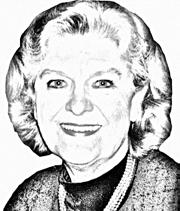

ANGELA O’BYRNE (P. 32) is the president of national architecture, design-build, and real estate development firm Perez, APC. She champions the principles of smart growth in her home community of New Orleans and in her frequent travels across the country and abroad. Born in Cali, Colombia, Angela is a licensed architect in over a dozen states, a licensed general contractor in Louisiana, a Fellow of the American Institute of Architects, and a member of the National CREW Network (Commercial Real Estate Women) Board of Directors. A singer, golfer, music-lover, and globetrotter, she relishes spending free time with her three grown children and large extended family. She is a Contributing Editor of and her Amazing Buildings feature appears in every issue.
ROXANA TOFAN (P. 40) is the owner of Clear Integ-rity Group in San Antonio, Texas and the company’s principal broker in Texas, Ohio and South Carolina. Her main focus is multifamily commercial brokerage in San Antonio area and property management. She enjoys taking over nonperforming properties and turning them around. She is also a Contributing Editor of and her Profiles of Survival will appear in every issue. In addition to her company, her passion is giving back to the community as she volunteers for various support organizations such as Boy Scouts of America, Special Olympics, Alzheimer’s Association and supporting the military. She loves to travel with her teenage children and supporting their extra-curricular activities.


JESSE WEISSBURG (P. 41) is an accomplished business development leader with experience across a variety of industries — including finance, real estate development, construction and renewable energy — managing strategic relationships and providing customized financial solutions to help organizations meet their goals. Recognizing cash flow inefficiencies in the commercial construction industry, he co-founded Billd, a disruptive payment solution that provides access to upfront funds for materials, helping contractors and suppliers alike grow their businesses. As senior vice president of business development, he supervises all sales, marketing, and business development efforts for Billd.

THE UPSIDE OF DOWNTIME...
Fans of will love these compilations of humor from the last decade. The Best of Diversions is just that – the very best of the hilarious Diversions that have appeared on the pages of the magazine. Vertical Lines is over a hundred pages of wit, witticisms and sarcasm that have appeared between the


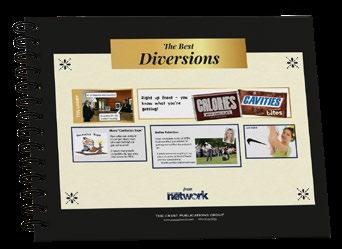
the network bookshelf on days off on off-days on rainy Sundays if you’re alone if you need a break to pass the time to brighten your day to sharpen your skills to open your mind to make you smile turn to
www.crestnetwork.com

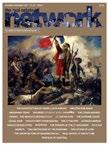
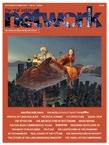
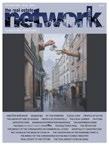
pages (”in the gutter”, as they say). They are both available at your favorite online bookseller and you can see samples at the link here My Handbook is… well… look at the cover comments and a few sample pages. You’ll know soon enough if it’s for you.

- 7 - / THE NETWORK / MAY/JUNE 2021
SARAH CRUMP (P. 42) is a Research Assistant at the Brookings Metropolitan Policy Program.
YOU NEED (OR MIGHT WANT) TO KNOW Editor’s note
ANDREW FELDER aafelder@crestpublicationsgroup.com Managing Editor & Publisher

RULES TO LIVE BY
Do not walk behinD me, for I may not lead. Do not walk ahead of me, for I may not follow. Do not walk beside me, either; just leave me the hell alone.
The journey of a thousand miles begins with a broken fan belt and a leaky tire.
It's always darkest before dawn. So, if you're going to steal your neighbor's newspaper, that's the time to do it.
Don't be irreplaceable; if you can't be replaced, you can't be promoted.
No one is listening until you make a mistake.
Always remember that you are unique…just like everyone else.
Never test the depth of the water with both feet.
It may be that your sole purpose in life is simply to serve as a warning to others.

It is far more impressive when others discover your good qualities without your help.
If you think nobody cares if you're alive, try missing a couple of car payments.
If at first you don't succeed, skydiving is not for you.
Before you criticize someone, you should walk a mile in their shoes. That way, when you criticize them, you're a mile away and you have their shoes.
Give a man a fish and he will eat for a day. Teach him how to fish, and he will sit in a boat and drink beer all day.
If you lend someone $20, and never see that person again, it was probably worth it.
Don't squat with spurs on.
If you tell the truth, you don't have to remember anything.
If you drink, don't park; accidents cause people.
Some days you are the bug, some days you are the windshield.
Don't worry, it only seems kinky the first time.
Good judgment comes from bad experience, and a lot of that comes from bad judgment.
The quickest way to double your money is to fold it in half and put it back in your pocket.
A closed mouth gathers no foot.
Experience is something you don't get until just after you need it.
Never miss a good chance to shut up.n
NEWSPAPER READERS
The Wall Street Journal is read by the people who run the country.
The New York Times is read by people who think they run the country.
The Washington Post is read by people who think they should run the country.
USA Today is read by people who think they ought to run the country but don't really understand the Washington Post. They do, however, like their smog statistics shown in colorful pie charts.
The Los Angeles Times is read by people who wouldn't mind running the country, if they could spare the time, and if they didn't have to leave L.A. to do it.
The Boston Globe is read by people whose parents used to run the country and they did a far superior job of it, thank you very much.
The New York Daily News is read by people who aren't too sure who’s running the country, and don’t really care, as long as they can get a seat on the subway.
The New York Post is read by people who don't care who's running the country either, as long as they do something really scandalous, preferably while intoxicated and when there are photographers present.

The San Francisco Chronicle is read by people who aren't sure there is a country, or that anyone is running it; but whoever it is, they oppose all that they stand for. There are occasional exceptions if the leaders are handicapped minority feministic atheist dwarfs, who also happen to be illegal aliens from ANY country or galaxy as long as they are democrats.
The Miami Herald is read by people who are running another country but need the baseball scores. The National Enquirer is read by people trapped in line at the grocery store. n
MY RESIGNATION

I hereby officially resign as an adult.
I've decided I would like to accept the responsibilities of an 8-year-old again. I want to go to McDonald's and think that it's a four-star restaurant. I want to sail sticks across a fresh mud puddle, and I want to make a sidewalk with rocks.
I want to think M&Ms are better than money because you can eat them. I want to lie under a big oak tree and run a lemonade stand with my friends on a hot summer day. I want to return to a time when life was simple - when all you knew were colors, multiplication tables and nursery rhymes, but that didn't bother you, because you didn't know what you didn't know, and you didn't care. All you knew was to be happy because you were blissfully unaware of all the things that should make you worried or upset.
I want to think the world is fair. I want to think that everyone is honest and good. I want to believe that anything is possible. I want to be oblivious to the complexities of life and be overly excited by the little things again. I want to live simple again. I don't want my day to consist of computer crashes, mountains of paperwork, depressing news, how to survive more days in the month than there is money in the bank, doctors’ bills, gossip, illness and lost loved ones.
I want to believe in the power of smiles, hugs, a kind word, truth, justice, peace, dreams, the imagination, mankind, and making angels in the snow.
So, here's my checkbook and my car keys, my credit card bills and my 401K statements. I am officially resigning from adulthood. And if you want to discuss it further, you’ll have to catch me first... Tag! You’re it! n
If it weren't for marriage, men would go through life thinking they had no faults at all.
- 8 - / THE NETWORK / MAY/JUNE 2021
I wondered why the baseball was getting bigger. Then it hit me.
Wow wow wow! This (our pictorial feature on Islamabad) is amazing! It highlights the amazing beauty of our city. I hope you share it with major newspapers across Pakistan.
Maria Tariq, Islamabad, Pakistan
THIS IS SOOOO COOL. How come I don’t know about this magazine? How do I subscribe?
Lisa Mochel, San Antonio, TX Ed. Thanks, Lisa! You just did (subscribe, that is)! Shhh. It’s a secret. Tell everybody!
I really enjoy the wide-ranging topics in every issue. I never know what to expect on the next page, so I go through the whole thing from coverto-cover. I don’t do that with any other magazine!

Kendra Thomason, Houston, TX
It used to bother me that your ‘real estate’ magazine had so much non real estate related stuff in it. I stopped reading it for a while because of that. But I have to say – maybe I was in a better mood when I flipped through the MarchApril issue – you really pull it off!

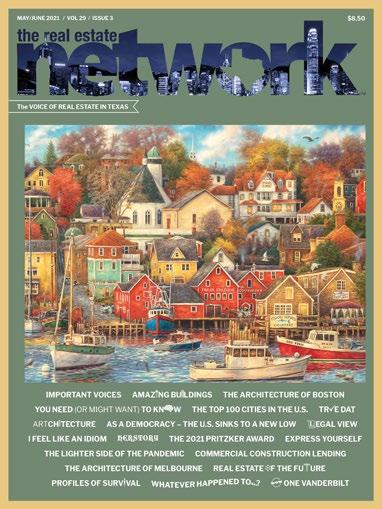
From informational to (sometimes hysterically) funny, from useful to quirky, it really is a lot of fun to read. Even the Texas focus doesn’t bother me. JYou won me back!.
Ron Bosnick, Oklahoma City, OK

Thank you for the article on Harriet Tubman. It inspired me to buy and read a biography about her. A really remarkable woman!
Deandra Phillips, Trenton, NJ
TIMES HARBOR'
by Chuck Pinson
Old harbor towns with their colorful architecture and seafaring history can be captivating. Towns such as this one, loosely based on Lunenburg, Nova Scotia, are places where fishing has typically been a mainstay for centuries. This painting invites the viewer to imagine experiencing the sights and sounds from an open-air cafe, while feasting on fresh seafood and watching the fishermen unload their catches, which may be exceeded by the stories they have to tell.
/ THE NETWORK / MAY/JUNE 2021 - 9 -
INB
X
'GOOD
ON THE COVER
THE TOP 100 CITIES IN THE U.S TO LIVE, WORK AND VISIT





we first introDuceD you to Resonance Consultancy, a British Columbia, Canada-based international research and consultancy group in real estate, tourism and economic development last year. Then, in our March/April issue, we synopsized their World’s Best Cities - 2021. Here we look at another of their studies, this time closer to home.
Resonance ranked American cities (principal cities of metropolitan areas with populations of more than 500,000) by using a combination of statistical performance and qualitative evaluations by locals and visitors in 26 areas grouped into six core categories - Place, Product, People, Prosperity, Programming and Promotion.
From the cover: “American cities are the engines of the nation and the badges of American ingenuity. Yes, they’ve stalled, exposing nationwide institutional problems manifesting on their streets and in their hospitals and senior homes. But they’re also leading – like they always have – the recovery and future-defining next stage of human innovation. Their citizens will gather again, colliding and creating the global culture, wealth and American energy that defines the global zeitgeist.”
Below are pictures of the top 10 and the whole list is here. Check out where your city comes in. (Houston was #11; Dallas was 14; Austin was 17; San Antonio was 28; and El Paso was 49.) n
- 10 - / THE NETWORK / MAY/JUNE 2021
Police were called to a day care where a three-year-old was resisting a rest.
5th
1st 4th
2nd
é
3rd
é
é New York
é Los Angeles
Chicago
é San Francisco
Washington DC
(Honey, I'm home. What the...?!)




10th

- 11 - / THE NETWORK / MAY/JUNE 2021
The male praying mantis cannot copulate while its head is attached to its body. The female initiates sex by ripping the males head off. 7th
6th
9th
8th
é Miami é San Jose
é San Diego
é Las Vegas
é Boston
YOU NEED (OR MIGHT WANT) TO KNOW YOU NEED (OR MIGHT WANT) TO KN W
THE “V-SIGN”
the age-olD V-sign comes in two formats: one with the palm faced outwards, and one with the palm inwards. In the United States, the two hand signals mean the same thing – “victory,” as popularized by Richard Nixon, or “peace and love,” which seemed to become the primary meaning after anti-Vietnam War protesters used it during the 60s.
However, if the outside of your hand is facing your target, you’re giving somebody a long-established insult in Great Britain and many English-speaking countries such as Australia, Ireland and New Zealand. Winston Churchill famously used the incorrect version of the V-sign during the early years of the war, switching around later when he’d been told by his advisers that he wasn’t exactly giving the lower social orders a positive message. The V sign is also considered rude in Italy, especially if you place your nose between the two fingers, making the gesture resemble a crude vagina.
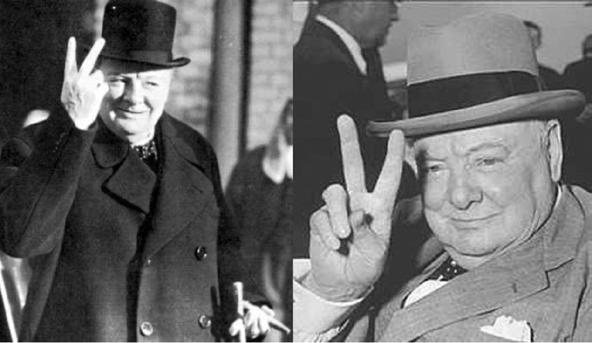
So, simply sticking two fingers up to convey the number ‘2’ is perfectly normal on this side of the Atlantic (it’s actually the signal for the number ‘2’ in American Sign Language), but it’s fighting talk to the British.
HOW DOES A BATTERY GET ITS POWER?
Electrical energy in a battery is generated by a chemical reaction. In the case of a lead-acid battery, a mixture of sulfuric acid and water, known as electrolyte, reacts with active material inside the battery. A battery’s voltage largely depends on the concentration of sulfuric acid. n 1799, Italian physicist Alessandro Volta created the first battery by stacking alternating layers of zinc, brine-soaked pasteboard or cloth, and silver. This arrangement, called a voltaic pile, was not the first device to create electricity, but it was the first to emit a steady, lasting current. The chemical reaction starts when you insert a battery into a device – and complete the circuit. The electrolyte oxides the anode’s powered zinc. The cathode’s manganese dioxide/carbon mix reacts with the oxidized zinc to produce electricity. Interaction between the zinc and the electrolyte produces reaction products, which gradually slows the cell’s action and lowers its voltage. (Now you know where the word ‘voltage’ comes from.)

ALGORITHM
An algorithm is a procedure for solving a mathematical problem (as of finding the greatest common divisor) in a finite number of steps that frequently involves repetition of an operation broadly. It is a step-by-step procedure for solving a problem or accomplishing some end. Internet search engines (e.g., Google, Yahoo, Bing, Safari) each have its own proprietary computation (called an "algorithm") that ranks websites for each keyword or combination of keywords.

It is commonly used for the set of rules a machine (especially a computer) follows to achieve a particular goal. The term may also accurately be used of the steps followed in making a pizza or solving a Rubik’s Cube as for computer-powered data analysis.
Algorithm is often paired with words specifying the activity for which a set of rules have been designed. A search algorithm, for example, is a procedure that determines what kind of information is retrieved from a large mass of data. An encryption algorithm is a set of rules by which information or messages are encoded so that unauthorized persons cannot read them.
The term itself actually has a deep history. It was formed from algorism “the system of Arabic numerals,” a word that goes back to Middle English and ultimately stems from the name of a 9th-century Persian mathematician, abu-Ja'far Mohammed ibn-Mūsa al-Khuwārizmi, who did important work in the fields of algebra and numeric systems.
Did you hear about the guy whose whole left side was cut off? He’s all right now.
- 12 - / THE NETWORK / MAY/JUNE 2021
ç Alessandro Giuseppe Antonio Anastasio Volta was an Italian physicist, chemist, and pioneer of electricity and power who is credited as the inventor of the electric battery and the discoverer of methane.
AMERICAN FOOTBALL

The history of American football can be traced to early versions of rugby football and association football. Both games have their origin in multiple varieties of football played in the United Kingdom in the mid-19th century, in which a football is kicked at a goal or kicked over a line, which in turn were based on the varieties of English public school football games descending from medieval ball games.
American football resulted from several major divergences from association football and rugby football. In 1869, the first intercollegiate contest took place between Rutgers and Princeton, an event which gave space and brought popularity to university American Football.
The man most responsible for the transition from this rugby-like game to the sport of football we know today was Walter Camp, known as the “Father of American Football.”

As a Yale undergraduate and medical student from 1876 to 1881, he played halfback and served as team captain, equivalent to head coach at the time. Even more importantly, he was the guiding force on the rules board of the newly formed Intercollegiate Football Association (IFA). Thanks to Camp, the IFA made two key innovations to the fledgling game: It did away with the opening “scrummage” or “scrum” and introduced the requirement that a team give up the ball after failing to move down the field a specified yardage in a certain number of “downs.” Among the other innovations Camp introduced were the 11-man team, the quarterback position, the line of scrimmage, offensive signalcalling and the scoring scale used in football today. In addition to his work with the rules board, Camp coached the Yale team to a 67-2 record from 1888 to 1892—all while working as an executive at a watch-manufacturing firm.
In the late 19th and early 20th centuries, gameplay developments by college coaches such as Eddie Cochems, Amos Alonzo Stagg, Parke H. Davis, Knute Rockne, and Glenn "Pop" Warner helped take advantage of the newly introduced forward pass. The popularity of college football grew as it became the dominant version of the sport in the United States for the first half of the 20th century. Bowl games, a college football tradition, attracted a national audience for college teams. Boosted by fierce rivalries and colorful traditions, college football holds widespread appeal in the United States.
The origin of professional football can be traced back to 1892, with Pudge Heffelfinger's $500 (estimated $13,246.55 in 2019 dollars) contract to play in a game for the Allegheny
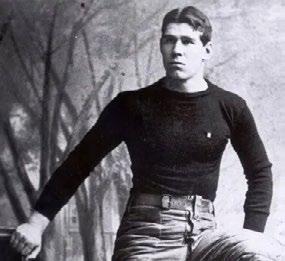
Athletic Association against the Pittsburgh Athletic Club. In 1920 the American Professional Football Association was formed. This league changed its name to the National Football League (NFL) two years later, and eventually became the major league of American football. Primarily a sport of Midwestern industrial towns in the United States, professional football eventually became a national phenomenon.
The modern era of American football can be considered to have begun after the 1932 NFL Playoff game, which was the first indoor game since 1902 and the first American football game to feature hash marks, forward passes anywhere behind the line of scrimmage, and the movement of the goalposts back to the goal line. Other innovations to occur immediately after 1932 were the introduction of the AP Poll in 1934, the tapering of the ends of the football in 1934, the awarding of the first Heisman Trophy in 1935, the first NFL draft in 1936 and the first televised game in 1939.
Another important event was the American football game at the 1932 Summer Olympics, which combined with a similar demonstration game at 1933 World's Fair, led to the first College All-Star Game in 1934, which in turn was an important factor in the growth of professional football in the United States. American football's explosion in popularity during the second half of the 20th century can be traced to the 1958 NFL Championship Game, a contest that has been dubbed the "Greatest Game Ever Played". A rival league to the NFL, the American Football League (AFL), began play in 1960; the pressure it put on the senior league led to a merger between the two leagues and the creation of the Super Bowl, which has become the most watched television event in the United States on an annual basis. n

- 13 - / THE NETWORK / MAY/JUNE 2021 When
fish are in schools, they sometimes take debate.
é Walter Chauncey Camp.
é Pudge Heffelfinger, the first professional football player.












TOO
TO
Text FIX IT to 40649 to ask your elected officials to be part of the most proven and effective solution to fix recycling.
nonprofit organization, Recycle Across America created the first and only standardized labels for recycling bins. This simple solution is referred to as “one of the most important environmental fixes taking root today” by the New York Times.
.
SOLUTION: The standardized labels on recycling bins make it easy for people to recycle right! It’s that simple.
RECYCLING IS
IMPORTANT
BE CONFUSING.
The
LET’S FIX IT
THE
MARAN
volunteer
for Recycle Across America Message and data rates may apply. Text STOP to cancel or HELP for help. Go to recycleacrossamerica.org/privacy-policy for privacy and terms
JOSIE
Actress and
advocate

Anticipating tomorrow’s workplace challenges, today. KYOCERA Document Solutions Southwest, LLC 469-574-0041 | Kyoceranevill.com ©2020 KYOCERA Document Solutions America, Inc.
TR E DAT: WHERE DID THAT COME FROM?


A proxy marriage is when the marriage is performed despite one or both parties not being physically present at the ceremony. In most of the United States, marriage by proxy is not allowed, but there are a few places that allow it, such as the states of Colorado, Kansas, Montana, and Texas.

FOR NEARLY 60 YEARS, TEXAS DIDN’T HAVE AN OFFICIAL STATE FLAG –BETWEEN 1879 & 1933. DURING THAT TIME, THE LONE STAR FLAG WAS THE ACTIVE, BUT THE UNOFFICIAL FLAG.

The term horsepower came about in the late 18th century. The development of the steam engine provided a reason to compare the output of horses with that of the engines that could replace them. One horse can have approximately 15 horsepower. One horsepower is about 746 watts.


PLUTO WAS FIRST DISCOVERED IN 1930 BY 21-YEAR-OLD ASTRONOMER CLYDE TOMBAUGH; IT IS ONLY ABOUT TWO-THIRDS THE SIZE OF OUR MOON. IT TAKES SUNLIGHT 5.5 HOURS TO REACH PLUTO, COMPARED TO THE 8 MINUTES IT TAKES TO REACH EARTH. IT TAKES 247.9 EARTH YEARS FOR PLUTO TO ORBIT THE SUN ONCE. (IT IS 3.7 BILLION MILES FROM THE SUN AND HAS A SURFACE TEMPERATURE OF –9.4 DEGREES FAHRENHEIT.)
RUSSIA'S AREA IS LARGER THAN THE TOTAL SURFACE AREA OF PLUTO. IT IS THE LARGEST COUNTRY (BY AREA) ON EARTH AT 6,601,699 SQUARE MILES. PLUTO, BY COMPARISON, IS JUST 6,430,000 SQUARE MILES.

/ THE NETWORK / MAY/JUNE 2021 - 16 -
The short fortune teller who escaped from prison was a small medium at large.
IKEA is an acronym which stands for Ingvar Kamprad Elmtaryd Agunnaryd , which is the founder’s name, the farm where he grew up, and his hometown.
In 117 AD, the Roman Empire was at its peak – covering a huge surface area of over 5 million square miles!
The world’s first electronic television was producedbyPhiloT.Farnsworthin 1927. Sliced bread was invented in 1928
by Otto Rohwedder.
Astronaut is a compound word derived from the two Ancient Greek words “Astro” meaning “star” and “naut” meaning “sailor”. So, astronaut literally means “star sailor”.




THE FACTOR ONE VANDERBILT
one VanDerbilt is a 67-floor supertall skyscraper at the corner of 42nd Street and Vanderbilt Avenue in midtown Manhattan in New York City. Proposed by New York City mayor Bill de Blasio and developer SL Green Realty as part of a planned Midtown East rezoning in the early 2010s, the tower stands immediately west of Grand Central Terminal. (SL Green is a publicly traded New York office landlord. As vacant space climbs, it has seen its shares drop 45% from the beginning of the pandemic.)
A groundbreaking ceremony for One Vanderbilt was held in October 2016; the tower topped out

in September of 2019 (two months ahead of schedule) and the building opened in September 2020. The 1.6-million-square-foot skyscraper's roof is 1,301 feet high and its spire is 1,401 feet, making it the city's fourth-tallest building.
Because of the pandemic, office leasing activity in the city has nosedived, and the work-from-home culture has raised questions about the future demand for office space. About 70% of the space was preleased, and the deals being negotiated now reflect the softer market – somewhat lower rents and more concessions such as free rent and landlord contributions to interior build-out. n

/ THE NETWORK / MAY/JUNE 2021 - 17 -
Why is the man who invests all your money called a broker?
MR. POTATO HEAD WAS THE FIRST TOY TO BE ADVERTISED ON TV.
German Chocolate Cake is named after an American baker by the name of Samuel German.
St. Lucia is the only country in the world named after a woman. The country was named after Saint Lucy of Syracuse by the French.
AFFILI TE NEWS
THE FACTOR








SHANGHAI TOWER
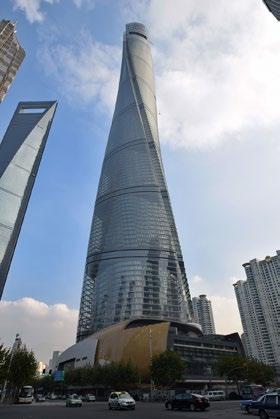

shanghai tower is a 128-story (2,073 ft)-tall skyscraper in Shanghai, China. It is the world's secondtallest building by height to architectural top and it shares the record (along with the Ping An Finance Center) of having the world's highest observation deck within a building or structure. It had the world's second fastest elevators at a top speed of 67.5 feet per second (or 46 mph) until it was surpassed, in 2017, by the Guangzhou CTF Finance Center, with its top speed of 69 feet per second - or 47 mph.)
Designed by international design firm Gensler and owned by the Shanghai Municipal Government, the building’s tiered construction was designed for high energy efficiency. It contains nine separate zones divided between office, retail, and leisure use. The tower was completed in September 2014, though the sightseeing deck on the 118th floor has only been open to the public since April of 2017. Since opening the tower has had significant maintenance issues and remains largely unoccupied – but it sure is an eye-catcher. n
- 18 - / THE NETWORK / MAY/JUNE 2021
Sex is one of the nine reasons for reincarnation; the other eight are unimportant.
Greg Abbott (Zenith Roofing).
Andi Perry (Transwestern) and Marissa Virgadamo (NAI Partners).
Rhett Caraway (Fort Worth Window Cleaning).
Industry Partner Eric Hancock and Greg Sherman, CPM (Brookfield Properties).
The chapter hosted a rodeo-themed happy hour on March 25th at the Armadillo Palace and raised funds for the Houston Livestock Show and Rodeo.
New and long-time members mingling over drinks. n
2021 BOARD OF DIRECTORS

President: Ashley Tinsley, Project Engineer, Reeder Construction.
President-Elect: Shonnah Driver, Associate, Director of Marketing and Business Development, Baird, Hampton and Brown, Inc.
Past President: Anita Beard, PLA, Landscape Architect, Dunaway Associates.
Treasurer: Monica deLaGarza, OWT Architects.
Secretary: Dana Compton, Director of Business Development, Ridgemont Commercial Construction.
Directors:
Kirsten Cessna, RID; IIDA; LEED AP BD+C, Senior Associate, Gensler.
Caroline Claure, Vice President of Development, CHC Development.
Haley McCarthy, RID, IIDA, LEED Green Associate, Bennett Benner Partners Architects + Planners.

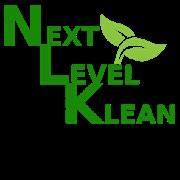
Ann Morris, Vice President / Loan Officer, Amrican National Bank & Trust.
Andrea Taylor, PE, Project Manager, MMA.
SIOR, the world’s premier organization for office and industrial real estate professionals, has announced its Top Transactions Award Winners of 2020. SIOR members represent the world’s elite in commercial brokerage, and the Top Transaction Awards are presented to SIORs who have completed the largest sales and lease transactions around the world, all ranked by dollar volume.


This year, nearly 500 SIOR members reported more than 1800 transactions, totaling 117 million square feet and USD $10.7 billion in leases and sales in the industrial, investment, office, land, alternative assets, and redevelopment sectors.
The largest transaction of 2020 was completed by Mark Erickson, SIOR, Brockton Hall, SIOR, Dave Mathews, SIOR, Grant Miller, SIOR, Donald Moss, SIOR, Matthew Pickard, SIOR Member Associate, Charles Salley, SIOR, Garrett Scott, SIOR, and Robert Speir, SIOR, all of Colliers International, who arranged the $184 million sale of 5.5 million sq. ft. of industrial space in multiple locations in South Carolina.

These members received awards for the largest member-to-member (M2M) industrial transaction and largest M2M investment transaction.
Rounding out the top five transactions by dollar volume qualifying for 2020 awards are the following:
• Jill Rasmussen, SIOR, of Davis, arranged the $160,663,000 sale of 438,690 sq. ft. of office space in various locations in Minnesota, winning awards for both the largest individual (non-M2M) office transaction and the largest non-M2M investment transaction.
• Kristopher Davis, SIOR, and Brett Price, SIOR, both of Newmark Levy Strange Beffort, arranged the $124,735,000 sale of 529,822 sq. ft. / 34 acres of office space in Oklahoma City, Okla, winning the award for largest M2M office transaction.

• Kevin Higgins, SIOR, of CBRE, arranged the $123,784,090 lease of 649,136 sq. ft. of industrial space in North Las Vegas, Nev., winning the award for the largest non-M2M industrial transaction.

• Brockton Hall, SIOR, and Garrett Scott, SIOR, of Colliers International, along with Mike Demperio, SIOR Affiliate Member with CRG | Clayco, arranged the $96,186,016 lease of 1,400,580 sq. ft. of industrial space in Spartanburg, S.C., winning the award for the largest M2M affiliate transaction.
In total, 23 members won awards in 14 different categories. Visit the SIOR website for a complete list of the 2020 SIOR Transaction Awards.
SIOR has also recognized the Top 50 Office Deals, Top 50 Industrial Deals, Top 10 Office Sales, Top 10 Office Leases, Top 10 Office Investment and Top 10 Industrial Investment. For a complete list of the 2020 SIOR Top Transaction lists, click here n

/ THE NETWORK / MAY/JUNE 2021 - 19 -
FIRST IMPRESSIONS COUNT! You deserve to work in an eco-friendly, clean, sanitized environment. Your carpet is your largest filter of allergens, dirt, bacteria, and viruses. When it is truly clean, your flooring promotes your health and that of your staff and clients. www.NextLevelKlean.com Jason@NextLevelKlean.com Jason Cox 214-991-2988 A thief who stole a calendar... got twelve months.
AFFILI TE NEWS

/ THE NETWORK / MAY/JUNE 2021 - 20 -
A thief fell and broke his leg in wet cement. He became a hardened criminal.
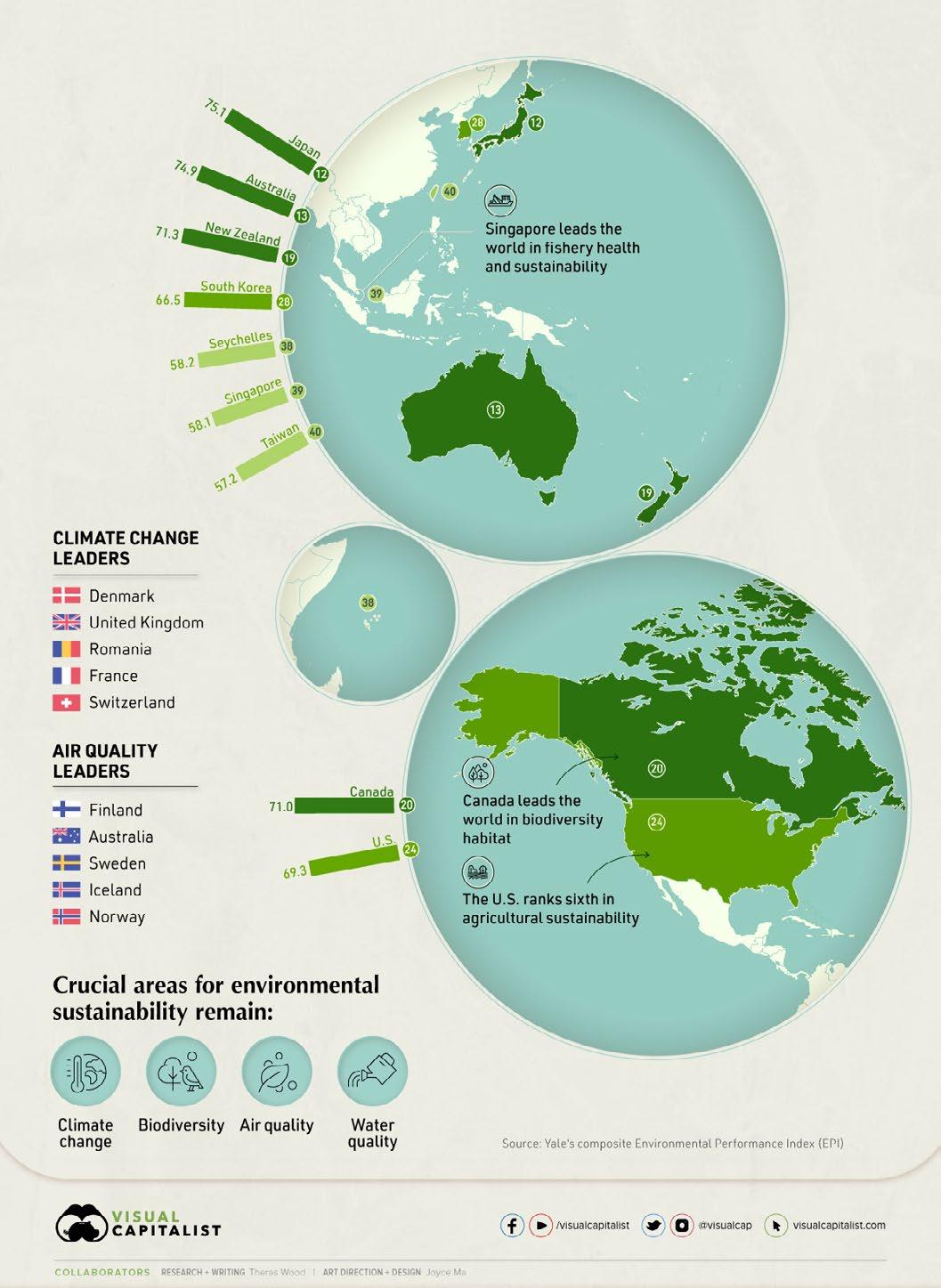
/ THE NETWORK / MAY/JUNE 2021 - 21When the smog lifts in Los Angeles, U. C. L. A.
THE BUILDINGS OF HOUSTON

the architecture of houston includes a wide variety of awardwinning and historic examples located in various areas of the city. From early in its history to current times, the city inspired innovative and challenging building design and construction, as it quickly grew into an internationally recognized commercial and industrial hub.

Some of Houston's oldest and most distinctive architecture is found downtown, as the city grew around Allen's Landing /01/ and the Market Square historic district. Downtown Houston has grown into the third largest skyline in the United States. The Uptown District experienced rapid growth during the 1970s and early 1980s, and is home to structures designed by architects such as I. M. Pei, César Pelli and Philip Johnson.
The Rice Hotel, /02/ built in 1912 on the former site of the old Capitol building of the Republic of Texas, was restored in 1998, after years of standing unused. William Marsh Rice (the founder of Rice University) added a five-story annex and renamed it the Rice Hotel (1883). This historic hotel now serves as an apartment building known as The Rice Lofts.
The Gulf Building /03/ (now the JPMorgan Chase building) is a 37-story (430 ft) Art Deco skyscraper. Completed in 1929, it remained the tallest building in Houston until 1963, when the Exxon Building /04/ surpassed it in height.
The Niels and Mellie Esperson buildings /05/ are examples of Italian Renaissance architecture in downtown Houston (built in 1927 and 1941 respectively are detailed with massive columns, great urns, terraces, and a grand tempietto at the top.
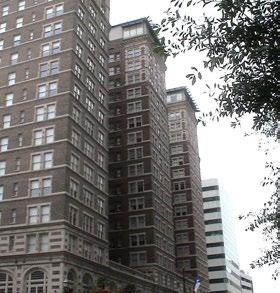
The first major skyscraper to be constructed in Houston was the 50-floor, 715 ft tall One Shell Plaza /06/ in 1971. A succession of skyscrapers were built throughout the 1970s, culminating with Houston's tallest, the 75-floor, 1,002-foot tall JPMorgan Chase Tower (formerly the Texas Commerce Tower), designed by I. M. Pei and completed in 1982. /07/ An antenna on top brings the height to 1,000 ft. When built, the tower was the tallest in the city. The surge of skyscrapers that followed mirrored the skyscraper booms in other sunbelt cities, such as Los Angeles and Dallas.
Pennzoil Place, /08/ designed by Philip Johnson and built in 1976, is Houston's most award-winning skyscraper and is known for its innovative design. The 46-story One Houston Center /09/ (built in 1978)
is 678 ft tall. In 1983, the Wells Fargo Bank Plaza /10/became the second-tallest building in the city and in Texas, and the 11th-tallest in the country. It is 71 stories tall (972 ft) and extends four more stories below street level.
Completed in 1984, the Bank of America Center /11/ is one of the first significant examples of postmodern architecture built in downtown. The 53-story Heritage Plaza (1986) /12/was the last major office build-ing completed in downtown Houston prior to the collapse of the Texas real estate, banking, and oil industries in the 1980s.
JPMorgan Chase Tower /13/ (built between 1979 and 1981) is the tallest composite building in the world. It is the tallest building in Texas, the tallest five-sided building in the world, the 22ndtallest building in the United States, and the 107th-tallest building in the world. The building boom of the 1970s and 1980s ceased in the mid-1980s, due to the 1980s oil glut. Building of skyscrapers resumed by 2003, but the new buildings were more modest and not as tall.
The tallest structure in Uptown Houston is the 64-story 909 ft tall, Philip Johnson-designed, landmark Williams Tower /14/ (formerly "Transco Tower"), which was constructed in 1983. At the time, it was to be the world's tallest skyscraper outside of a city's central business district. The building is topped with a rotating spotlight that constantly searches the horizon. it was named "Skyscraper of the Century" in the December 1999 issue of Texas Monthly magazine. n
- 22 - / THE NETWORK / MAY/JUNE 2021
The dead batteries were given out free of charge.
01 02


























- 23 - / THE NETWORK / MAY/JUNE 2021 Age is a very high price to pay for maturity. Supergrit® Type 231BF “Make Every Step a Safe One” Wooster Products Inc. 800-321-4936 www.woosterproducts.com sales@wooster-products.com PROUDLY MADE IN THE USA 03 07 12 11 13 08 09 14 10 04 05 06
EXPRESS YOURSELF
the english language may have the most words of any language, but sometimes there are no comparable words to express the same idea embodied in other languages.
the majority of the population. Yet, in spite of the painful, oppressive system, many of those most deeply affected by it rose up and remained resolute and united – with some crediting one philosophical concept, that of ubuntu, as a guiding ideal. The presence of ubuntu is still widely referenced in South Africa, more than two decades after the end of apartheid. It’s a compact term that carries a fairly broad English definition of “a quality that includes the essential human virtues of compassion and humanity.” In modern South Africa, though, it’s often simplified further and used as a catch-all phase for the country’s moral ideals, spirit of togetherness, ability to work together towards a common goal or collective humanity.
Saudade is a Portuguese term that is a common fixture in the literature and music of Brazil and Portugal. It has many definitions, including a melancholy nostalgia for something that may not even have happened. It often carries an assurance that this thing you feel nostalgic for will never happen again. Portuguese writer Manuel de Melo said it is "a pleasure you suffer, an ailment you enjoy."
The German word zielschmerz means to imagine the thrilling dread of finally chasing a long-held dream. The Arabic tarab is a state of enchantment or ecstasy that only music can induce.
You’ve probably felt the guilty pleasure of schadenfreude—the German word for experiencing joy at others’ misfortune. Or curled up on the couch for some hygge—the Norwegian concept of contented coziness. But what about ikigai and mamihlapinatapai? When you sit down for a meal, are you looking forward to the sobremesa or the shemomechama?
Food matters a lot in Spain, but the social aspect of it matters even more. Lunch, for example, doesn’t end when people can’t eat another bite. That’s when the sobremesa starts. There is no equivalent word in English, though the concept is simple: it's the time you spend at the table after you’ve finished eating. Usually, there’s laughter involved, and almost always the kind of easy, convivial conversation that only the pleasures of a big meal can inspire.
The natives of Tierra del Fuego, Argentina have the word mamihlapinatapai for a look shared between two people when both are wishing the other would do something neither wants to. In Thai there is greng-jai — when you don't want someone to do something for you because it would be a bother for him or her.
In the West, the Japanese concept of ikigai has been popularized as a way to find purpose. It is what brings you joy in your daily life - not something you need to find, but rather something you already have. Knowing how to see it allows you to enjoy what you do rather than chase what you think you might enjoy.

In Indonesia, jayus is a word to describe a joke that is so unfunny that one cannot help laughing. They are the jokes that fall cataclysmically flat, cringeworthy, uninspired. They often don’t have a punchline — the climactic zinger that makes everyone laugh — and the silence that follows is so awkward that you must force up a laugh just to fill the dead air.
Uitwaaien is a popular activity in Denmark - one believed to have important psychological benefits. It’s basically the activ-

The Finns have a tradition of getting drunk at home in their underwear. It’s so commonplace, there's a word for it, kalsarikännit. And two emojis: a man in gray underwear with pint of beer, and a woman in a polka-dot slip with a glass of red wine. In English, the rough translation is ‘pantsdrunk.’ And if there was ever a time for pantsdrunk to become a trend in America, it’s probably now, when people are self-isolating at home. Sisu, a kind of stoic determination, is how Finns express their national character.
South Africa is a country that carries massive collective trauma. Apartheid (institutionalized racism) was devastating for

/ THE NETWORK / MAY/JUNE 2021 - 24 -
Lady: “Sir, you are drunk!” Winston Churchill: “And you are ugly. The difference is that tomorrow I will wake up sober.”
Schadenfreude Kalsarikännit
Greng-jai
ity of spending time in the wind, usually by going for a walk or a bike ride - something you do to clear your mind and feel refreshed, to destress. There’s also hygge, the Danish concept of cozying up with candles, blankets, and nourishing meals.
The Swedish word for a lifestyle that encourages balance and mindfulness in everything that you do - lagom - translates roughly to: “not too little, not too much,”
DIVERSI NS TERRIBLE TRUTHS (AND OTHER PRINCIPLES OF DISASTER)
In our July-August issue we will present the granddaddy of these kinds of things – Murphy’s Law (“Anything that can go wrong will go wrong.”) and MANY of its corollaries. For now, here are some laws you may not have already heard.
Schmidt's Observation:
All things being equal, a fat person uses more soap than a thin person.
Nick the Greek's Law of Life:
All things considered, life is 9 to 5 against.
Nowlan's Theory:
He who hesitates is not only lost, but several miles from the next freeway exit.
Van Roy's Law:
Honesty is the best policy; there's less competition.
Van Roy's Truism:

Life is a whole series of circumstances beyond your control.
Agnes' Law:
Almost everything in life is easier to get into than out of.
Clarke's Conclusion:
The Hebrew word firgun describes taking pleasure in another’s good fortune. The German waldeinsamkeit is ‘the feeling of being alone in the woods,’ while the Pascuense word tingo is ‘to gradually steal all the possessions out of a neighbor’s house by borrowing and not returning them.’

The Japanese have a saying: “The misfortunes of others taste like honey.” The French speak of joie maligne, a diabolical delight in other people’s suffering. The Danish talk of skadefryd, and the Dutch of leedvermaak. In Hebrew, enjoying other person’s catastrophes is simcha laed, in Mandarin it's xìngzāilèhuò, in SerboCroat it is zlùradōst and in Russian it's zloradstvo. More than 2,000 years ago, Romans spoke of malevolentia. Earlier still, the Greeks described epichairekakia. “To see others suffer does one good,” wrote Friedrich Nietzsche. “To make others suffer even more so.”
For Georgians, shemomechama is when you’re full but you continue eating, when you didn’t intend to eat so much but something tasted so good that you couldn’t resist. You blame it on the food – and not the eater – for tasting so good.
The word namaste dates back to Old

Never let your sense of morals interfere with doing the right thing.
Goda's Truism:

By the time you get to the point where you can make ends meet, somebody moves the ends.
Wilner's Observation:
All conversations with a potato should be conducted in private.
Zall's Laws:
(1) Any time you get a mouthful of hot soup, the next thing you do will be wrong. (2) How long a minute is depends on which side of the bathroom door you're on.
Ettore's Observation:
The other line always moves faster.
Griffin's Thought:
When you starve with a tiger, the tiger starves last.
Manly's Maxim:
Logic is a systematic method of coming to the wrong conclusion with confidence.
Cann's Axiom:
When all else fails, read the instructions.
Macaluso's Doctrine:
You've never been as sick as just before you stop breathing.
Knebel's Law:
It is now proved beyond doubt that smoking is one of the leading causes of statistics.
William's Law:
In
Papua
New Guinea, laughing at other people’s pain is known as banbanam.
The smiles of Schadenfreude and joy are indistinguishable except in one crucial respect: we smile more with the failures of our enemies than at our own successes.
Sanskrit, from what is now Pakistan and the northwestern corner of India. The first part comes from ‘namaha,’ a word that originally meant ‘to bend.’ Over time, it went from meaning ‘to bend’ to meaning ‘greetings,’ (because people bent when they greeted each other). The ‘te’ means "to you," so all together, namaste literally means ‘greetings to you,’ or ‘hello.’ ¡Guay! n
There is no mechanical problem so difficult that it cannot be solved by brute strength and ignorance.
/ THE NETWORK / MAY/JUNE 2021 - 25 -
An archeologist is someone whose life is in ruins.
Waldeinsamkeit
Namaste
THE ARCHITECTURE OF MELBOURNE
the capital of the state of Victoria and the second most populous city in Australia, Melbourne is characterized by a wide variety of styles dating from the early years of European settlement to the present day. The city is particularly noted for its mix of Victorian architecture and modern buildings, with 52 skyscrapers (buildings 490 feet or taller) in the city center, the most of any city in the Southern Hemisphere.
Melbourne's Victorian heritage was not valued, and much was demolished, eventually leading to protests and the establishment of the Victorian Heritage Register in 1974. Buildings on the register's heritage list include the /02/ Royal Exhibition Building, the /03/ General Post Office, the /04/ State Library of Victoria and /05/ Flinders Street Railway Station.
The postwar period ushered in a new boom, with the city hosting the 1956 Summer Olympics, and the lifting of height limits at the same time led a boom in high rise office building, beginning with /06/ ICI House, itself now in the Heritage Register.
historic buildings, specifically the /07/ Federal Coffee Palace and APA Building And the contrast between the older and newer buildings /08/ became even greater. /09/ 140 William Street (1972) is one such example of the contemporary style which evolved.
Melbourne is the Sister City of Boston which was featured in our January-February issue.

01/ The Queen Anne style APA Building, built in 1889, was one of the world's tallest buildings in the 1890s and the tallest in the Southern Hemisphere. It was demolished in 1981.


In the wake of the 1850s Victoria gold rush, Melbourne entered a lengthy boom period, earning the moniker 'Marvelous Melbourne' to represent its wealth and grandeur. By the 1880s, it had become one of the largest and wealthiest cities in the British Empire, second only to London. The wealth generated during this period is reflected in much of the city's grand, richly ornamented Victorian architecture, as well as the height of some buildings, with the 12-story /01/ APA Building (1889) rivalling other early skyscrapers in Chicago and New York City. In the post WW2 era, as in many western cities,

The 1956 Olympic Games were the first to be held in the Southern Hemisphere (as well as the first to be held outside Europe and North America). Due to the Southern Hemisphere's seasons being different from those in the Northern Hemisphere, the 1956 Games did not take place at the usual time of year, because of the need to hold the events during the warmer weather of the host's spring/summer (which corresponds to the Northern Hemisphere's autumn/winter). Australia did not host the Games again until 2000 in Sydney, New South Wales.
The ensuing years of the 1970s and 80s saw the loss of some of Melbourne's most admired
Since the 2000s, the central city and Southbank area have seen a new boom in high rise construction, with some blocks developed to very high densities /10/, and the tallest buildings in Australia, including the 92-floor /11/ Eureka Tower, which was the tallest residential tower in the world when completed in 2006. It was surpassed by /12/Australia 108 which was built from 2015 – 2020.
The juxtaposition of old and new has given Melbourne a reputation as a city of no characterizing architectural style, but rather an accumulation of buildings dating from the present back until the European settlement of Australia.
02/ The Royal Exhibition Building was built in 1880 and, in 2004, became the first building to be given a World Heritage Site listing in Australia. It was designed by Joseph Reed of Reed and Barnes architecture, who also designed the Melbourne Town Hall and the State Library of Victoria.
03/ The General Post Office, owned by the Federal Govern-

- 26 - / THE NETWORK / MAY/JUNE 2021
I’m always relieved when someone is giving a eulogy and I realize I’m listening to it.
01 02 03
ment, appears on all major heritage lists where it is noted for its fine and impressive architecture and historical significance. Construction started in 1861 (but wasn’t completed until 1907).
building. Begun in 1955, it was the tallest building in Australia upon completion in 1958, breaking Melbourne's long standing 132 ft height limit, and was the first International Style skyscraper in the country. It symbolized progress, modernity, efficiency and corporate power in postwar Melbourne, and was closely modelled on the best of corporate design being pioneered in the United States with all-glass high-rise like the United Nations headquarters.
public observation deck. On the left is the Winfield Building (built in 1891), and on the right, dwarfing the Victorian era buildings, are the Rialto Towers.
04/ The State Library Victoria is the main library of the Australian state of Victoria. It was established in 1854 and is Australia's oldest public library and one of the first free libraries in the world. It is also Australia's busiest library; in 2018, it was the fourth mostvisited library in the world.
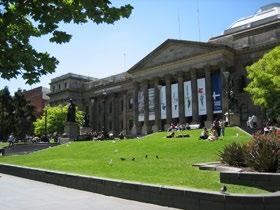
05/ Flinders Street Railway Station opened in 1854. The historic building is the busiest station on Melbourne's metropolitan network and was reputedly the world's busiest passenger station in the 1920s. Its main platform is Australia's longest, and the fourth longest railway platform in the world.

07/ A cable tram passes the ornate Victorian Gothic Federal Coffee Palace, a hotel in the center of the city, dated approximately between 1890 to 1900. It is prominent in lists of the buildings Melbournians most regret having lost.

09/ 140 William Street (formerly BHP House) is a 41-story steel, concrete and glass building in the central business district. Built between 1969 and 1972, its design was influenced by the contemporary skyscrapers in Chicago. At the time, it was the tallest steel-framed building and the first office building in Australia to use a “total energy concept” – the generation of its own electricity.
06/ ICI House (now Orica House) is a 19-story office

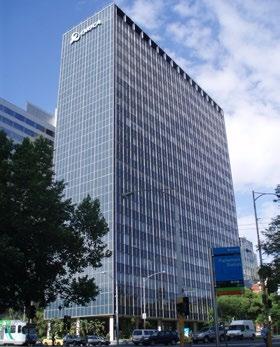
08/ Rialto Towers is a skyscraper in the central business district. It was the tallest office building in the Southern Hemisphere when it was constructed (1982-1986) and it featured the city's first skyscraper
10/ The Docklands is a waterfront area known for its striking contemporary architecture. The suburb is home to a number of heritage buildings that have been retained for adaptive reuse, and is also the site of landmarks such as the Docklands Stadium, Southern Cross Station and the Melbourne Star Observation wheel.

11/ Eureka Tower is a 975 ft skyscraper built between 2002 and 2006. It was the world's tallest residential tower when measured to its highest floor, until surpassed by Ocean Heights and the HHHR Tower
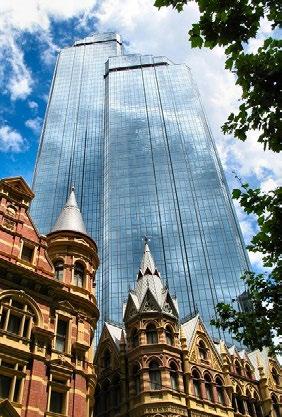
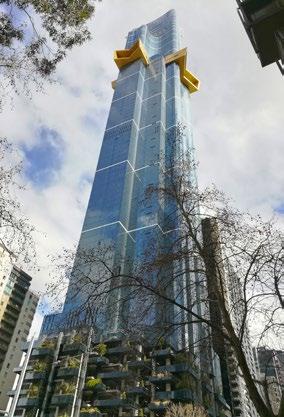
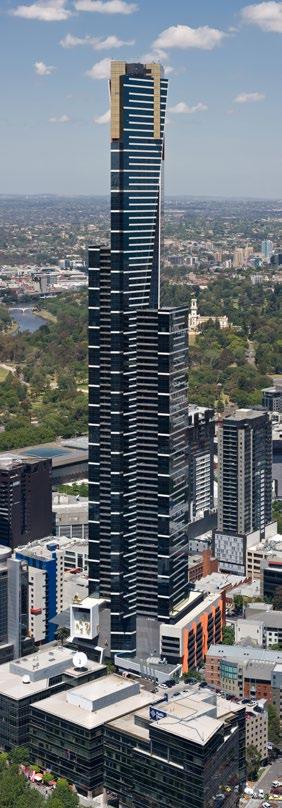
in Dubai. From 2006 to 2019, it was the tallest building in Melbourne. It is currently the third tallest building in Australia
12/ Australia 108 (previously 70 Southbank Boulevard) is a residential supertall skyscraper which, when completed in 2020, became the tallest building in Australia. It is 1,039 ft tall and has 1,105 apartments over 100 floors.
- 27 - / THE NETWORK / MAY/JUNE 2021 A will is a dead giveaway.
n 04 05 06 07 10 08 11 09 12
REAL ESTATE F THE FU URE THE NEW KIRIBATI

the republic of kiribati is an independent island nation in the central Pacific Ocean. The permanent population is over 119,000 (2020), more than half of whom live on Tarawa atoll (the capital). The state comprises 32 atolls and one raised coral island, Banaba. They have a total land area of (313 square miles) and are dispersed over 1.4 million square miles. It is the only country in the world to be situated in all four hemispheres.

Kiribati gained its independence from the United Kingdom, becoming a sovereign state in 1979. It is a member of the Pacific Community (SPC), Commonwealth of Nations, the IMF, and the World Bank, the OACPS and became a full member of the United Nations in 1999. As an island nation, the islands are very vulnerable to climate change and addressing climate change has been a central part of its international policy.
Teburoro Tito was the President and foreign minister of Kiribati from 1994 to 2003. He was appointed Kiribati’s Permanent Representative to the United Nations in 2017 and Ambassador to the US in 2018. He has described unequal country contributions to climate change by saying, “The islands are ants and industrialized nations are elephants.” That’s what Kiribat is – a handful of atolls (in the middle of what most of us would call ‘nowhere’) whose climate and very future existence is in the hands of the giant countries of the world.
- 28 - / THE NETWORK / MAY/JUNE 2021
Time flies like an arrow; fruit flies like a banana.
Feature
Amsterdam- and London-based design practice UOOU Studio has come up with a futuristic proposal that would substantially reduce the impact of global warning (i.e., swelling seas due to the ice melting at the poles) – floating houses.
In a democracy it’s your vote that counts. In feudalism, it’s your Count that votes.
According to the UOOU website, “The design offers a high level of flexibility both on the village-level and the house-level, allowing for a step-by-step, organic growth over time. Parts of the village and the housing unit remain open and unfinished, allowing for a gradual evolution as the population grows, people’s needs



change, and the environment transforms due to climate change. The overall structure resembles that of a tree: the access to the town center symbolizes the tree’s trunk while the modular blocks including the housing units represent the branches. These grow organically over time.”
Apart from domestic space, the design accommodates an everpresent open-air space in the very center of each living unit. Photo-voltaic panels are the primary source of electricity supply and are aimed to ensure electrical self-sufficiency of the housing units. They are placed on the slightly tilted roof to maximize the exposure to sunlight and to collect rainwater.

The look and feel of the living spaces is created to welcome, not alienate the people for whom the houses are intended. Natural and tactile materials like wood and bass are selected to blend in with the built surroundings and local material language. The boundaries between indoors and outdoors is hardly visible when it comes to how the house is experienced in everyday life. The design welcomes the surroundings - the sunlight, the sky, the view of the Pacific Ocean - to inhabit it and help it acquire the identity that it can only have in this specific geo-location, this climate, this unique part of the world. n

- 29 - / THE NETWORK / MAY/JUNE 2021
the toby awarD is more than the result of a one-year competition. It is the reward of many years of dedication and attention to detail and of relentless passion for excellence. It is truly evidence of the character of all of those who contribute to making it happen. A reputation is the opinion of others — and all the nominees have earned an outstanding reputation. Character is who you are.
Since 1985, The Outstanding Building of the Year Award has been recognizing excellence in building management, operating efficiency, tenant retention, emergency planning and community impact. It is unquestionably


among the most prestigious and comprehensive programs of its kind. Every building in the competition (as well as everyone who leads a management or service team that supports these build-ings) is a winner!
Featured here are the entries and winners of the Southwest regional competition. Photographs, building standards, floor plans and the owner’s goals are all part of the appearance portion of the judging. That’s the part we get to see, but collectively these elements constitute only 5 % of the score a building receives. The remaining 95% is based upon tenant relations, community impact, emergency and security
standards, environmental and regulatory policies, energy management systems, and personnel training and qualifications.

This year’s winners (the ones with the stars) were announced on April
SOUTHWEST REGION LOCAL CHAPTERS
Arkansas – Greater Little Rock, Northwest Arkansas Louisiana – New Orleans, Shreveport.
New Mexico – Albuquerque. Oklahoma City – Oklahoma City, Tulsa.
Texas – Austin, Corpus Christi, Dallas, Fort Worth, Houston, San Antonio.
SUBURBAN OFFICE MID-RISE
9th in a virtual event. The winners move on to the international competition in June, and those buildings will be featured in one of our next two issues. Good luck to all of the regional winners! n
Management Company: Parkway


Property Manager: Chris Ball

Greater Dallas Chapter
Houston Chapter

- 30 - / THE NETWORK / MAY/JUNE 2021
A chicken crossing the road is poultry in motion.
GREENHILL TOWERS
Management Company: Crescent Property Services
Property Manager: Jonathan Jones
é Southwest Region Outstanding Member of the Year, Kristine Lang.
CITYWEST PLACE
100,000 – 249,999 SQUARE FEET



250,000 – 499,999 SQUARE FEET

511 EJC
Management Company: Crescent Property Services
Property Manager: Jonathan Jones
Greater Dallas Chapter
500,000 – 999,999 SQUARE FEET
MANDALAY TOWER II
Management Company: Parmenter Realty Partners

Property Manager: Kelly Smith and Beth Parkhurst
Greater Dallas Chapter
MCKINNEY & OLIVE
Management Company: Crescent Property Services

Property Manager: Angelique Wade
Greater Dallas Chapter


AMEGY TOWER
Management Company: Hines Interests Limited Partnership
Property Manager: Sarah Sutton
Houston Chapter
- 31 - / THE NETWORK / MAY/JUNE 2021 If you don’t pay your exorcist, you can get repossessed.
AMAZ NG BU LDINGS
ANGELA O’BYRNE aobyrne@e-perez.com

CORRECTING THE RECORD: NEW YORK GETS A NEW GATEWAY
history is not always kind to great design. What seems like sure-footed progress in one era can often look more like series of missteps with additional hindsight and changing values. We’ve all seen renovations that only made things worse, robbing a property of its original charm, mistreating historical materials, or simply ruining the romance of a space.
However, what happened to New York’s Pennsylvania Station in 1963 stands alone as a crime against architecture. Its decapitation—to make way for the new Madison Square Garden overhead—was so regrettable that it launched the historical preservation movement in the United States
After more than five decades, New York is still reckoning with the legacy of the loss. However, in January 2021, the city partially healed an architectural wound with the opening of the Moynihan Train Hall. The result of a $1.6 billion conversion of a historic post office facility, the project finally returned a worthy threshold to one of the city’s busiest transit hubs through a little creative problem-solving and a commitment to civic grandeur.
Many young New Yorkers would be shocked to learn that Pennsylvania Station—a rundown and cramped punchline of a place with its low ceilings and confusing underground tunnels—once rivaled Grand Central Terminal in majesty. But when it was completed in 1910, Pennsylvania Station was an absolute marvel, spreading over two city blocks and flanked by dozens of elegant columns.


Designed by McKim, Mead, and White, the Beaux-Arts icon, when it opened it was the largest indoor space in the city, rivaling St. Peter’s Basilica in scale. Modeled after the Baths of Caracalla in
Rome, the station’s immense, light-filled main waiting room had a 150-foot ceiling, welcoming travelers to the city with a generous and impressive flourish.
However, as rail travel fell out of favor and the city’s priorities shifted, Pennsylvania Station gradually lost its luster. The building’s pink granite had taken on the grime of the city and haphazard maintenance left the building a shadow of its former self. By
- 32 - / THE NETWORK / MAY/JUNE 2021
Feature
A grenade fell onto a kitchen floor in France, and resulted in Linoleum BlownaparL
Angela O’Byrne, FAIA, is President of Perez, APC, a 70+ year-old architecture, planning, interior design, and construction firm. She is also a Contributing Editor of
the 1950’s, the Pennsylvania Railroad was seeking a buyer for the building’s air rights, citing upkeep costs for the massive complex.
But when the wrecking balls came in 1963, the citizens found themselves shocked by the station’s perfunctory destruction. When a New York Times photographer captured one of the building’s sculptures in a New Jersey landfill, regret came quickly. Within two years, the city passed a landmarks preservation act, which would save Grand Central Terminal and prevent the destruction of countless other historic buildings.
For decades, New Yorkers bemoaned Pennsylvania Station’s lost glory. But serendipitously, Pennsylvania Station wasn’t the only massive Beaux Arts building in the neighborhood. McKim, Mead, and White had also designed the James A. Farley Building, which still stands on Eighth Avenue. Originally meant to adjoin and complement the station, the complex served as a mail-sorting hall with direct access to some of the tracks.
Throughout the 1990’s, Daniel Patrick Moynihan, the late Senator from New York, began lobbying to repurpose a section of the Farley Building as a new train hall. In 2016, Governor Andrew Cuomo seized the reins of the project and deputized Skidmore, Owings & Merrill to perform the conversion. Despite the pandemic, the project came across the finish line early and under budget, opening on the first day of 2021.

The result is breathtaking—an optimistic and audacious combination of historical splendor and smart modern design. With its ample public space, retail tenants, and handsome waiting areas with walnut benches, it’s sure to become a destination for Instagram tourists looking to capture the New York of tomorrow.
The train hall’s stunning glass ceiling boasts exposed steel trusses and four bulbous vault sections that jut dramatically into the sky. And in the heart of it all is a beautiful Art Deco clock, reminiscent of an era when we looked up for the time instead of squirreling for our phone in our pockets and purses.
While the Moynihan Train Hall isn’t a full replacement for Pennsylvania Station, it gestures in the right direction: ahead. Talks are already underway to connect the building with the High Line pedestrian park and a long-planned initiative promises to extend the regional Metro-North railway system to the west side of Manhattan.
While Pennsylvania Station will never match its former glory, it could still return to its former prominence as old ideas—like rail travel and prominent civic spaces—come back into style once again. n


- 33 - / THE NETWORK / MAY/JUNE 2021
had a photographic memory which was never developed.
He
US SINKS TO NEW LOW IN RANKINGS OF WORLD'S DEMOCRACIES
freeDom house is a democracy watchdog organization that (since the 1950s) annually rates people’s access to political rights and civil liberties in 195 countries and 15 territories through its Freedom in the World report. It is a US government-funded non-profit, non-governmental group whose methodology is derived in large measure from the Universal Declaration of Human Rights, adopted by the UN General Assembly in 1948. It is extremely detailed (and can be reviewed here.)

The report is based on the premise that certain standards apply to all countries and territories, irrespective of geographical location, ethnic or religious composition, or level of economic development. It assesses the real-world rights and freedoms enjoyed by individuals, rather than governments or government performance, per se, because political rights and civil liberties can be affected by both state and nonstate actors, including insurgents and other armed groups. The 2021 ranking of all 210 entities can be found here.
Freedom House measures the level of democratic governance in 29 countries from Central Europe to Central Asia through its annual Nations in Transit report. The democracy score incorporates separate ratings on national and local governance, electoral process, independent media, civil society, judicial framework and independence, and corruption. From this link, you can access the full country narrative report for each of those countries.
They also assess the level of internet freedom in 65 countries around the world through their annual Freedom on the Net report.
The US earned 83 out of 100 possible points in Freedom House’s 2021 rankings, an 11-point drop from its ranking of 94 a decade ago. The US’s new ranking places it on par with countries like Panama, Romania and Croatia and behind countries like Argentina and Mongolia. And far behind countries like the United Kingdom (93), Chile (93), Costa Rica (91) and even Slovakia (90). Overall, the U.S. ranked an appalling 61st on the list! Not surprisingly, Finland, Sweden and Norway topped the list.

- 34 - / THE NETWORK / MAY/JUNE 2021
Those who get too big for their britches will be exposed in the end.
è ‘Freedom status’ of each country.
Green = ‘Free’
Orange = ‘Partly Free’
Purple = ‘Not Free’.
A SHIFTING INTERNATIONAL BALANCE

In 2020, the number of "Free" Countries in the world reached its lowest level since the beginning of a 15-year period of global democratic decline, while the number of "Not Free" countries reached its highest level.
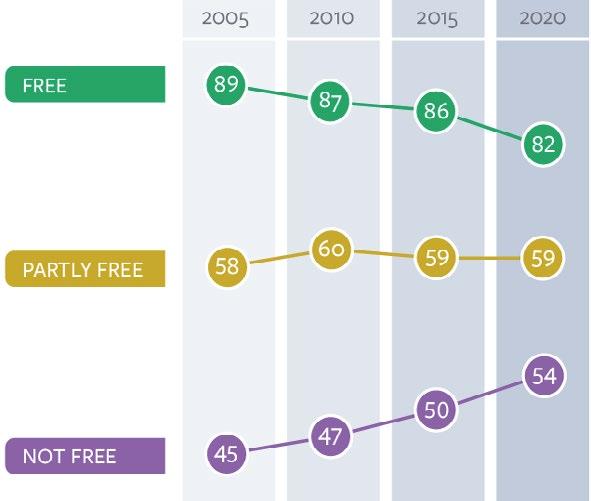
Countries with scores of 72 or higher were regarded as ‘Free’, with Brazil, Israel and Bulgaria among the countries only narrowly making it into the top tier. The next category – "Partly Free" – included major global players such as India and Hong Kong (where China has imposed a major security crackdown in the last year).
“Dropping 11 points is unusual, especially for an established democracy, because they tend to be more stable in our scores,” said Sarah Repucci, Freedom House’s vice-president for research and analysis.. “It’s significant for Americans and it’s significant for the world, because the United States is such a prominent, visible democracy, one that is looked to for so many reasons.”

- 35 - / THE NETWORK / MAY/JUNE 2021 A cheap shot is a terrible thing to waste.
ç Sarah Repucci.
While Freedom House has long included the US in its global ranking of freedoms, it traditionally has not turned an eye inward and focused on US democracy. But this year, Repucci authored an extensive report doing just that, a move motivated by increasing concern over attacks on freedoms in the US. The report details the inequities that minority groups, especially Black people and Native Americans face when it comes to the criminal justice system and voting. It also illustrates that public trust in government has been damaged by the way rich Americans can use their money to exert influence on American politics
It points out that extreme partisan gerrymandering – the manipulation of electoral district lines to boost one party over the other – has contributed to dramatic polarization in the US, threatening its democratic foundations. Gerrymandering, the report says, has had a “corrosive and radicalizing effect on US politics.” And, obviously, the widespread assault on voting rights, the initially weak oversight of the $1 trillion Covid-19 relief package and improper PPE contracts (which made the US more corrupt), and fanatics rampaging through Congress in an attempt to overturn an election result didn’t help.

The report states, “As a lethal pandemic, economic and physical insecurity, and violent conflict ravaged the world in 2020, democracy’s defenders sustained heavy new losses in their struggle against authoritarian foes, shifting the international balance in favor of tyranny. Incumbent leaders increasingly used force to crush opponents and settle scores, sometimes in the name of public health, while beleaguered activists—lacking effective international support—faced heavy jail sentences, torture, or murder in many settings.
These withering blows marked the 15th consecutive year of decline in global freedom. The countries experiencing deterioration outnumbered those with improvements by the largest margin recorded since the negative trend began in 2006. The long democratic recession is deepening.”
“We’re really concerned about these longer-term challenges that

- 36 - / THE NETWORK / MAY/JUNE 2021
When you’ve seen one shopping center you’ve seen a mall.
éThe global trend in freedom. Those in yellow, orange or red have lost freedoms over the last year; those in green have gained freedoms.
aren’t going to be addressed with quick fixes, that were kind of highlighted during the Trump administration and, in some cases, taken advantage of, by that administration.” Repucci said. “A change of president is not gonna make them go away.”
The report offers three recommendations for improving American democracy: removing barriers to voting, limiting the influence of money in politics, and establishing independent redistricting commissions. Democrats in Washington are pushing all three
of those reforms as part of a sweeping voting package currently under consideration in the US Senate.
“Americans should see it as a wake-up call,” Repucci said. “American democracy is still strong, and we still have a lot going for us especially in the strength of our institutions and in the mobilization that is possible among the population. I do think that these problems can be solved, and people should take heart in that.” n
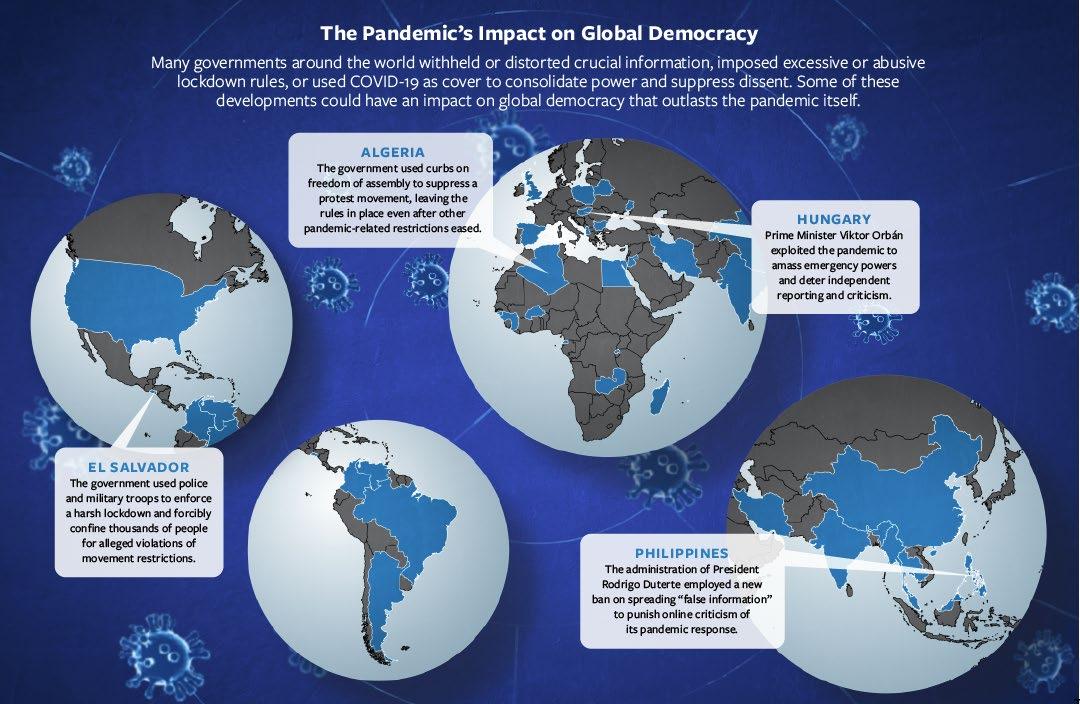
If you jump off a Paris bridge, you are in Seine.
DIVERSI NS REDNECK SAT ANSWERS (SUPPOSEDLY)

Q: What is a planet?
A: A body of earth surrounded by sky.
Q: What causes the tides in the oceans?
Q: Name a major disease associated with cigarettes.
A: Premature death.
Q: How are the main parts of the body categorized? (e.g., abdomen)
Q: How do you delay milk turning sour?
A: Keep it in the cow.
Q: What is a seizure?
Q: Explain one of the processes by which water can be made safe to drink.
A: Flirtation makes water safe to drink because it removes large pollutants like grit, sand, dead sheep and canoeists.
Q: How is dew formed?
A: The sun shines down on the leaves and makes them perspire.
A: The tides are a fight between the Earth and the Moon. All water tends to flow towards the moon, because there’s no water on the moon, and nature abhors a vacuum. I forget where the sun joins in this fight.
Q: What are steroids?
A: Things for keeping carpets still on the stairs.
Q: What happens to your body as you age?
A: When you get old, so do your bowels and you get intercontinental.
A: The body is consisted into three parts – the brainium, the borax and the abdominal cavity. The branium contains the brain; the borax contains the heart and the lungs; and the abdominal cavity contains the five bowels – A, E, I, O and U.
Q: What is the fibula?
A: A small lie.
Q: What is the meaning of the term “Caesarean Section”?
A: The caesarian section is a district in Rome.
A: A Roman emperor.
Q: What is a terminal illness?
A: When you are sick at the airport.
Q: What does the word “benign” mean?
A: Benign is what you be after you be eight.
Q: What does “varicose” mean?
A: Nearby.
Q: Name the four seasons.
A: Salt, pepper, mustard and vinegar.
- 37 - / THE NETWORK / MAY/JUNE 2021
THE 2021 PRITZKER ARCHITECTURE PRIZE
The international prize was established by the Pritzker family of Chicago through their Hyatt Foundation in 1979. It is granted annually and is often referred to as “architecture’s Nobel” and “the profession’s highest honor.” The award consists of $100,000 and a bronze medal-lion. It is conferred on the laureate(s) at a ceremony held at an architecturally significant site throughout the world.

through their Design of private and social housing, cultural and academic institutions, public spaces, and urban developments, Lacaton and Vassal reexamine sustainability in their reverence for pre-existing structures, conceiving projects by first taking inventory of what already exists. By prioritizing the enrichment of human life through a lens of generosity and freedom of use, they are able to benefit the individual socially, ecologically and economically, aiding the evolution of a city.
The purpose of The Pritzker Architecture Prize is to honor a living architect or architects whose built work demonstrates a combination of those qualities of talent, vision, and commitment, which has produced consistent and significant contributions to humanity and the built environment through the art of architecture.
On March 16, 2021, AnneLacaton and JeanPhilippe Vassal of France were named as the 2021 Pritzker Architecture Prize Laureates

“Not only have they defined an architectural approach that renews the legacy of



modernism, but they have also proposed an adjusted definition of the very profession of architecture. The modernist hopes and dreams to improve the lives of many are reinvigorated through their work that responds to the climatic and ecological emergencies of our time, as well as social urgencies, particularly in the realm of urban housing. They accomplish this through a powerful sense of space and materials that creates architecture as strong in its forms as in its convictions, as transparent in its aesthetic as in its ethics,” states the 2021 Jury Citation, in part.
The architects increase living space exponentially and inexpensively, through winter gardens and balconies that enable inhabitants to conserve energy and access nature during all seasons. Latapie House
/ THE NETWORK / MAY/JUNE 2021 - 38 -
Do infants enjoy infancy as much as adults enjoy adultery?
é Residential and Office Building.
ç 129 Units, Ourcq-Juarès Student and Social Housing.
é École Nationale Supérieure d’Architecture de Nantes.
The nice part about living in a small town is that when you don't know what you're doing, someone else does.
(Floirac, France 1993) was their initial application of greenhouse technologies to install a winter garden that allowed a larger residence for a modest budget. The east-facing retractable and transparent polycarbonate panels on the back side of the home allow natural light to illuminate the entire dwelling, enlarging its indoor communal spaces from the living room to the kitchen, and enabling ease of climate control.
“Lacaton and Vassal are radical in their delicacy and bold through their

subtleness, balancing a respectful yet straightforward approach to the built environment,” said Alejandro Aravena, Chair of the Pritzker Architecture Prize Jury.
On a grander scale, alongside Frédéric Druot,the two transformed La Tour Bois le Prêtre (Paris, France 2011), a 17-story, 96-unit city housing project originally built in the early 1960s. The architects increased the interior square footage of every unit through the removal of the original concrete façade and extended the footprint of
the building to form bioclimatic balconies. Once-constrained living rooms now extend into new terraces as flexible space, featuring large windows for unrestricted views of the city, thus reimagining not only the aesthetic of social housing, but also the intention and possibilities of such communities within the urban geography.
“Our work is about solving constraints and problems, and finding spaces that can create uses, emotions and feelings. At the end of this process and all of this effort, there must be lightness and simplicity, when all that has been before was so complex,” explained Vassal. Lacaton insists, “Transformation is the opportunity of doing more and better with what is already existing. The demolishing is a decision of easiness and short term. It is a waste of many things—a waste of energy, a waste of material, and a waste of history. Moreover, it has a very negative social impact. For us, it is an act of violence.”
They established their practice, Lacaton & Vassal, in Paris in 1987, and have completed over 30 projects throughout Europe and West Africa. Lacaton and Vassal are the 49th and 50th Laureates of the Pritzker Architecture Prize. n


/ THE NETWORK / MAY/JUNE 2021 - 39 -
é Latapie House (1993) in Floriac, France.
All photos, courtesy of Phillipe Ruault.
é FRAC Nord-Pas de Calais (2013) Dunkerque, France.
ç Transformation of Grand Parc, 530 Units, Social Housing (with Frédéric Druot).
THE FACTOR
SUNRISE KEMPINSKI HOTEL
on the banks of Yanqi Lake, about an hour north of Beijing, China, this hotel is considered as a bright building like a sunrise in the city. The 318-foot-tall building consists of 21 floors and one of its floors (third floor) has a free-form shape that depicts the idea of a sun being lifted by the cloud. The rising sun depicts harmony, unity, and infinity
The glass facade (with approximately 10,000 pieces of glass panels spanning nearly 200,000 square feet) reflects nature lights to its surroundings at different levels. The entrance is shaped like the mouth of a fish which symbolizes prosperity.
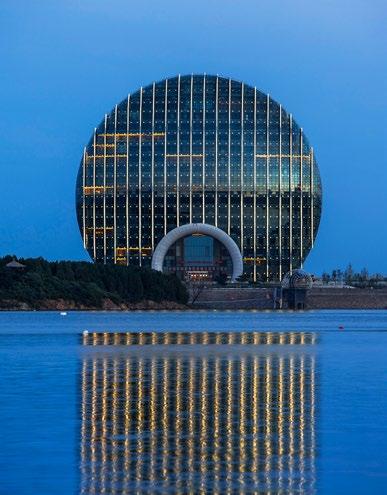

A team of 60 designers from across the globe, including China, UK, Italy, Spain, US, Holland and the Philippines took 60 days to develop the architectural design of this amazing building. 9,300 construction workers took part in the construction of the hotel which took 24 months to complete the huge building.


Men are all the same. They just have different faces so you can tell them apart.
panels fitted to the roof, exterior and other exposed parts of the building will produce clean energy. Solar power from the lake's solar PV panels located next to the hotel are also used for the LED lighting systems. The layered glass panels used for the building's façade help to reduce energy consumption.
Environmental protection and sustainable development were main considerations, and all types of advanced environmental protection technology were used in the construction of the building. The round shape of the building will not change the wind environment; on the contrary, the shape will help to maintain the original wind environment (and the wind plays a key role in the healthy growth of plants). n
/ THE NETWORK / MAY/JUNE 2021 - 40 -
Solar photovoltaic
WHAT FINANCING OPTIONS ARE AVAILABLE TO COMMERCIAL CONSTRUCTION CONTRACTORS?
as a commercial contractor operating with limited working capital, the pressure is tremendous—you are acutely aware that no matter how carefully you map out project timelines, the unpredictable nature of the business will eventually strike. One big delay can throw everything off schedule, wreaking havoc on your ability to maintain a healthy cash flow and balance sheet. Delayed payments for work performed also limit your ability to mobilize new projects effectively or take on larger jobs.
Over time, the strain of operating in such financial uncertainty takes a toll on your business, creating a compelling case for securing construction financing. What kind of financing is available, what potentially stands in the way, and what should you consider when evaluating your options?
TYPES OF CONSTRUCTION FINANCING

There isn’t a one size fits all approach for meeting the financial needs of a construction business. Here are some common financing methods along with their potential benefits and downsides.
Credit Cards: Credit cards can work well for everyday expenses (ideally those that are very short-term). There are often fewer hoops to jump through in obtaining a credit card for your business; however, they are not a desirable option for larger expenses. For example, putting large material purchases on your credit card when you won’t be able to pay off the balance within 30 days poses a risk—you might be left without access to credit for your everyday needs.
Bank Financing: Securing a line of credit can be helpful for your business, as it typically provides an attractive interest rate. As long as you can meet the bank’s payment terms, you may find they are willing to increase the amount you may borrow over time. Unfortunately, many commercial contractors find the nature of their business doesn’t translate well in the application process. Should you qualify for bank financing, be aware of the cons. One downside is the blanket lien the bank will want to include on your business, meaning your assets could be in jeopardy should you default on the loan. Another negative is the weight that the loan covenants often carry. Depending on the terms and conditions, a breach could mean the bank will claim the loan in full.
Alternative Financing: A popular form of alternative financing is FinTech lending, which attracts business owners as it’s more readily available and often comes with faster approvals. The application process is straightforward, and collateral isn’t always a requirement. Drawbacks are typically the lower dollar amounts offered and higher interest rates. Something else to keep in mind: FinTech isn’t specific to the construction industry.
Invoice Factoring: Though technically not a loan, invoice factoring is another way to finance business operations. By selling your accounts receivables to a third-party at a discount, you receive the funds for outstanding invoices. You’ll need to prove you’ve performed the work to obtain advance payment. Many commercial construction companies shy away from invoice factoring since it essentially
JESSE WEISSBURG jesse@billd.com
Jesse Weissburg is the co-founder and senior vice-president of Billd.

means you’ll lose control over communication with your general contractor. When this takes place, they may perceive you as being in a weaker financial position.
Material Financing: In the world of shortterm material financing, look for a non-bank financing partner that offers a payment solution designed to meet your needs as a commercial contractor. You should receive access to funds with terms that mirror your repayment cycle. When you establish a relationship with this kind of organization, there are several benefits. One standout is being able to purchase materials upfront with the flexibility of longer 120-day terms. Another advantage is the qualification process, since your personal and business experience, project pipeline and previous purchase history are taken into account. The right financing partner can have a transformative effect on your business—it could mean being able to double the number of projects you take on or handling larger, more complex jobs. When you are evaluating providers, make sure you understand their process and whether or not they can work with your current material suppliers.
COMMON HURDLES IN ACCESSING CAPITAL
Commercial contractors don’t typically have much of a business credit history. When it comes to your financial data, your receivables may raise red flags with lenders, especially if your general contractor(s) are stretching out their pay. Other challenges in getting financing approved include:
• Limited assets
• A weak balance sheet
• Material suppliers not reporting back to the credit bureau
It’s important to note that with material financing, your financial partner is generally focused on your upcoming project along with your credit history, increasing the likelihood of an approval and establishing the start to a healthy business relationship.
ARE YOU PREPARED FOR THE FUTURE?
As you evaluate your business growth strategy, remember that the best time to get approved for financing is now. Even if you don’t foresee a need for the funds, having resources aligned today will mean you are ready when (not if) the next downturn hits. n
/ THE NETWORK / MAY/JUNE 2021 - 41 -
Children seldom misquote you. In fact, they usually repeat word for word what you shouldn’t have said.
Feature
ALAN BERUBE
Alan Berube is a Senior Fellow and Deputy Director of the Metropolitan Policy Program at the Brookings Institution.

WITH RACIAL EQUITY ON AMERICA’S AGENDA, HOW INCLUSIVE WERE METRO AREAS IN THE PAST DECADE?
two of 2020’s heaDline events—the onset of the COVID-19 pandemic and its highly uneven impacts by race as well as the movement for racial justice in the wake of George Floyd’s death—are spurring renewed interest in policies and practices that can advance racial equity. Indeed, on his first day in office, President Joe Biden signed an executive order establishing a new interagency focus on racial equity and support for underserved communities within his Domestic Policy Council.
While such federal leadership is sorely needed, many of the factors that ultimately shape access to economic opportunity by race emerge at the local level. The extent of residential and occupational segregation, access to transportation and child care, and prevailing labor market conditions differ considerably across our regional economies. As a consequence, progress toward racial economic inclusion has proceeded—and receded—at different rates around the country over the past decade. Examining those patterns can offer clues as to what matters for achieving more racially equitable outcomes.
Racial inclusion is one key dimension of local economic success charted in the latest edition of Metro Monitor, Brookings Metro’s annual survey of inclusive economic growth and prosperity in America’s metropolitan areas. To assess racial inclusion, the latest Metro Monitor measures the degree to which each of the nation’s 192 largest metro area economies (those with populations of at least 250,000) narrowed gaps in employment, earnings, and relative poverty between white workers and workers of color between 2009 and 2019.[1] That time period roughly coincides with the decade-long economic expansion following the Great Recession, and thus provides a useful view into which places capitalized on that expansion to extend opportunity by income, race, and place.
METRO AREAS MADE UNEVEN PROGRESS ACROSS INDICATORS OF RACIAL INCLUSION
The results for U.S. metro areas on indicators of economic inclusion by race in the 2010s portray a mixed picture, with solid progress on employment but lost ground on earnings.
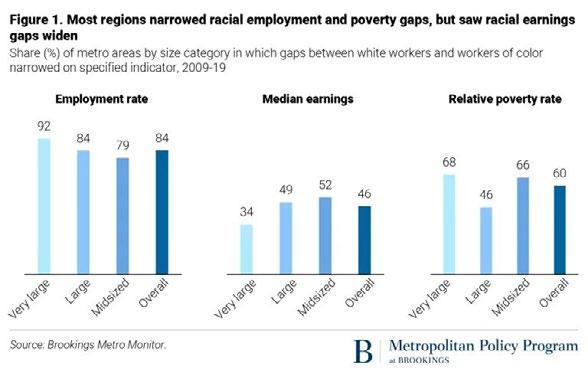
Between 2009 and 2019, the disparity in employment rates between white workers and workers of color narrowed in the overwhelming majority of metro areas. Disparities fell in more than nine in 10 very large metro areas (those with populations exceeding 1 million), and eight in 10 midsized metro areas (those with populations between 250,000 and 500,000). On average, the gap in the racial employment rate shrank from 8 to 9 percentage points in 2009 to 4 to 5 percentage points in 2019.
Progress on reducing earnings gaps, however, was much spottier. On this indicator, only one in three very large metro areas saw median earnings for their workers of color rise more than median earnings for white workers. A bare majority of midsized metro areas managed to narrow those gaps.
Across very large metro areas, an already gaping $14,000 median earnings disparity by race in 2009 grew by another $800 over the decade. Earnings for
Sarah Crump is a Research Assistant at the Metropolitan Policy Program at the Brookings Institution.

workers of color increased in nearly every very large metro area, but earnings for white workers rose by a greater degree in most. Even in regions like the San Francisco Bay Area—where median earnings for workers of color rose by more than $12,000 from 2009 to 2019—disparities increased as the median white worker enjoyed a $19,000 earnings increase.
SOME SURPRISING METRO AREAS PERFORMED STRONGLY ON RACIAL INCLUSION
Although true economic equity by race remains elusive, some regions have gained reputations as better places for people of color to make economic headway. For instance, Atlanta and Washington, D.C. are often noted for the size of their Black middle classes, and some metro areas in Texas and other fast-growing parts of the Sun Belt represent important incubators and destinations for the Latino or Hispanic middle class.
While some of those places made notable progress on racial inclusion in the 2010s, not all did, and other metro areas not typically known for racial equity made important strides in that direction. Among very large metro areas, a number of slower-growing regions—headlined by Rochester, N.Y., Grand Rapids, Mich., and Milwaukee—achieved the most positive results on closing racial economic gaps. This did not make them the most racially equitable metro areas in 2019; in fact, the employment rate gap between white adults and adults of color in all three of those regions continued to exceed the national average. But rapid growth was clearly not a prerequisite for narrowing racial disparities. In fact, many of the very large metro areas that performed weakest on racial inclusion were fast-growing regions in Florida and the Southeast.
Racial inclusion results for large (those with populations between 500,000 and 1 million) and midsized metro areas followed different geographic patterns. Many of the large metro areas that posted the weakest performance on racial inclusion were in slow-growing places in the Northeast and Southeast, while Sun Belt places and those with larger Latino or Hispanic populations featured among the top performers (with the exception of top-ranking Scranton, Pa.). The strongest-performing midsized metro areas were largely in the Northeast and Midwest, with workers of color in many exhibiting solid rebounds from the economic distress they had suffered in 2009.[2]
- 42 - / THE NETWORK / MAY/JUNE 2021
I was the next-door kid’s imaginary friend.
SARAH CRUMP
Important voices
time you wave, use all of your fingers.
MANUFACTURING AND HEALTH CARE HUBS LED ON RACIAL INCLUSION PROGRESS
Regional patterns on racial inclusion in the 2010s could reflect how different industries influenced outcomes for workers by race. To probe this, we examined the relationship between racial inclusion rankings for very large metro areas, and the share of metro jobs in major (two-digit NAICS) sectors.
Metro areas possessing greater concentrations of employment in manufacturing and health care tended to perform better on racial inclusion from 2009 to 2019. Very large metro areas with at least 10% of their jobs in manufacturing posted an average racial inclusion ranking of 21 (out of 53), compared to 30 in metro areas where fewer than 5% of jobs were in manufacturing. Similarly, very large metro areas with at least 15% of their jobs in health care had an average
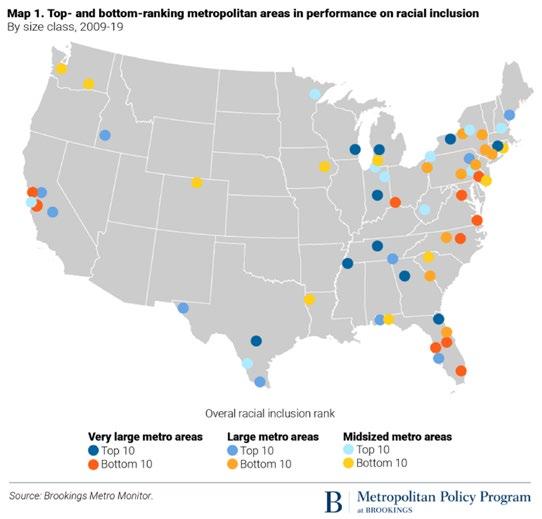
ranking of 22, compared to 34 in those where health care accounted for less than 12% of employment.

One reason manufacturing hubs may have outperformed others on racial inclusion in the 2010s is that the beginning of the decade was so difficult. The Great Recession hit manufacturing centers—and particularly their communities of color—very hard. In Milwaukee in 2009, for instance, only 62% of working-age people of color were employed, compared to 77% of white adults; additionally, 36% of workers of color there earned less than half of the regional median, compared to 25% of white workers. While significant racial disparities continued to afflict Milwaukee and many other manufacturing regions by 2019, the decade-long expansion and accompanying recovery of the manufacturing sector helped their communities of color to rebound economically from the crisis of 2009.
Health care hubs overlap to a degree with manufacturing hubs, so their stronger performance on racial inclusion may in part reflect the dynamics of the latter industry. But non-manufacturing centers with a strong health care presence— such as Pittsburgh, Providence, R.I., and Tucson, Ariz.—also outranked many others. The progress of workers of color in these metro areas may reflect the availability of jobs at many different education and skill levels in the health care industry, as well as the presence of career ladders that allow workers to increase their earnings over time. In Pittsburgh, for instance, 15% of Black workers are in health care occupations, versus 11% of white workers. And while many of the region’s Black workers are in lower-paying health care support jobs, the sector undoubtedly contributed to a significant rise in the employment rate for Pittsburgh’s people of color—from 59% in 2009 to 66% in 2019.

RACIAL INCLUSION MUST BE A RECOVERY PRIORITY
The data from this year’s Metro Monitor captures an important economic period, reflecting metro areas’ progress—or lack thereof— toward inclusive growth and prosperity across a decade-long macroeconomic expansion. However, the onset of the COVID-19 pandemic’s economic crisis (and its highly unequal effects by race) means that the work to build a more racially equitable economy has gained new urgency.
The metrics, trends, and insights from Metro Monitor 2021 should inform the growing number of local efforts to shape an inclusive recovery. As we’ve written previously, such efforts should set goals to increase regional prosperity and racial equity; support business dynamism, talent development, and connected communities with cross-cutting commitment to racial inclusion; and convene diverse partnerships to drive that work forward.
Click here to explore Metro Monitor 2021
Footnotes: [1] Combining Black, Latino or Hispanic, Asian American, Indigenous American, and other nonwhite populations into an omnibus “workers of color” category inevitably masks important differences in outcomes among these groups, who confront different economic opportunities and constraints. We do so in Metro Monitor in order to enable comparisons across metropolitan areas whose communities of color vary greatly in size and composition.
[2] Because of their smaller overall size and often smaller populations of color relative to larger metro areas, readers should view midsized metro areas’ racial inclusion values/rankings as suggestive rather than precise.
This article is reprinted here with permission. It was originally published on brookings.edu n
- 43 - / THE NETWORK / MAY/JUNE 2021 Next
THE FACTOR
TURNING TORSO


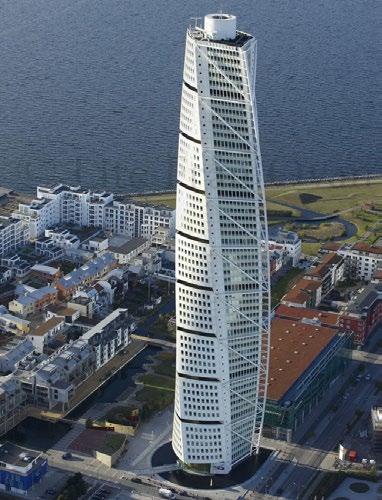


neo-futurism is a late-20th to early21st-century movement in the arts, design, and architecture. It has been seen as a departure from the attitude of postmodernism and represents an idealistic belief in a better future. Futurist architecture began in the 20th century starting with styles such as Art Deco and high-tech architecture.
The 623 ft tower was designed by renowned Spanish architect, structural engineer, sculptor and painter Santiago Calatrava and officially opened in 2005. (One of Calatrava’s sculptures was actually the inspiration for the design.) It is a constructed in nine segments of fivestory pentagons that ‘twist’ relative to each other as it rises; the topmost segment is twisted 90 degrees clockwise with respect to the ground floor. The two bottom segments are intended as office space. Segments three to nine house 147 apartments. Floor 49 is home to the public observation deck; floors 50–52 contain a private club, meeting events, and a restaurant, and floors 53 and 54 are conference rooms.
Turning Torso is a neo-futurist residential skyscraper in Sweden and the tallest building in Scandinavia Located in Malmö, Sweden and completed in 2005, it is regarded as the first twisted skyscraper in the world. (And it is way taller than any other structure in Malmö).
Malmö is the third-largest city in Sweden (after Stockholm and Gothenburg), and the sixth-largest city in Scandinavia, with a population of approximately 317,000 (The Öresund region, which includes Malmö as well as Copenhagen (just 18 miles away), is home to 4 million people. Malmö has a very mild climate for the latitude and normally remains above freezing in winter, with prolonged snow cover being rare.
n
/ THE NETWORK / MAY/JUNE 2021 - 44 -
To err is human; to arr is pirate.
In August 2015, the building won the 10 Year Award from the Council on Tall Buildings and Urban Habitat. Also in that year, it won the 2005 Gold Emporis Skyscraper Award.




PROFILES OF SURV VAL
ROXANA TOFAN roxana@clearintegritygroup.com
TITLE
Roxana Tofan is a commercial real estate and business broker and the founder and owner of Clear Integrity Group in San Antonio. She is also a Contributing Editor of since march 2020, the COVID-19 pandemic has severely impacted nearly all businesses. For property managers, the coronavirus crisis brought unique challenges. Social distancing, shelter-at-home mandates, travel restrictions, rent collection, and property maintenance are just some of the challenges that impacted landlords.
MARGARET MARTINEZ OF THE CLEAR INTEGRITY GROUP



In the property management field for 30 years, Margaret Martinez is the Vice President of Operations for CIG (Clear Integrity Group) in San Antonio. CIG provides property management and brokerage services for multi-family and commercial properties. Margaret shared how the “new norm” looks in a post-COVID-19 era.
Roxana: What kind of challenges did the pandemic bring to property managers?
Margaret: When COVID first hit we had no idea it would last this long. Conditions in which we operate at our apartment communities changed overnight. We had to think outside the box to overcome new difficulties and avoid spreading the virus. It was necessary to go digital and connect with residents without physical contact. We’ve adapted to regulatory changes like eviction moratoria and implemented new safety protocols at our properties. Property management is not something we can operate and oversee remotely. We had to not only keep our residents and staff safe, but we had to ensure properties still look good and maintenance emergencies are taken care. You could not do it all remotely.
Roxana: What kind of changes did your staff have to adapt to?
Margaret: First, everyone has to remember that property management staff working in apartment communities are essential workers. Residents needed us to take care of their homes. More residents were at home most of the time than before. Some of our office and maintenance staff did not want to come to work because they were afraid of being exposed to the virus. We had to reassure them that the safety and health of our residents and our teams simultaneously are
most important to us. We implemented strict masks requirements and social distancing. In an effort to manage traffic in the office, residents were only permitted to come in with an appointment. Initially, our maintenance staff only went in residents’ apartments for maintenance emergencies. All of these measures assured our staff we also cared about them and their safety.
Roxana: How did your residents respond to the changes?
Margaret: For most part residents complied with the masks and social distancing requirements, but we also had residents that refused to follow the new rules. We spent a lot of time explaining how important it is for everyone that we follow the CDC guidelines. This also included teaching more residents how to submit maintenance requests online, pay their rent online and communicate more via email, text, and phone versus coming into the office. I do believe residents have gotten used to it more and are liking that now, but it took time. The most important aspect of all the changes has been communicating with residents, letting them know we are here for them and providing resources for them to be able to address and solve their own situation and take care of their health during these times.
Roxana: How have collections been during COVID and what particular challenges did you face here?
Margaret: This all depended on the type of demographics at our properties. At the higher rent properties, we did not have much of a challenge collecting. This was mainly because
they were able to work from home and they continued to get a paycheck. At the lower rent properties where most of the residents worked outside the home, collections have been challenging. Even for those that qualified for unemployment, it took a while to receive their checks. There was rental assistance that the city and county provided, but many residents did not qualify to receive that help. With the eviction moratoria in place, we did not have necessary tools at our disposal to get people to pay their rent. Some took advantage of our inability to evict anyone and did not use their unemployment checks or income they had to pay rent. That has been frustrating. When Texas Rent Relief - the new program with rental assistance available - was launched, we hired a team member whose only tasks is to help residents apply for assistance. The process has been slow and those residents that owe many months of rent are still pending approval for assistance. In the meantime, regardless of collections, owners have had to pay for mortgage, property insurance, payroll, maintenance and the day-to-day operations.
Roxana: What about leasing?
Margaret: It was a bit slow for a while when many were not getting out of their homes, but leasing activity is starting to pick up. We have done a lot of virtual tours for our prospective residents. We had to replace some of our outreach marketing with online platforms. Overall, we are looking forward to being able to open our pools and have resident events.
COVID-19 has made the value of property managers more evident and in-demand than ever. The crisis management that has long been a primary aspect of property managers’ work has prepared them to adapt, shift, and innovate in the face of the unique challenges that have emerged in 2020. That has made property management companies feel confident in the future growth of their businesses.
/ THE NETWORK / MAY/JUNE 2021 - 46 -
Feature
If procrastinators had a club, would they ever have a meeting?
n
é Margaret Martinez
Ed. We thought of calling this new feature ‘I’ll Never Forget Old What’s His Name’ or ‘Where Are They Now?’ but this seemed to say it best. In words and pictures, we’ll look back at people (performers, athletes, politicians) you’ll remember (by name or appearance) but whom you haven’t heard about in a long time. If there’s someone you’re curious about seeing on this page in the future, just let us know.
She said she was approaching 40, and I couldn’t help wondering from which direction.
Gina Lollobrigida (born in 1927) is an Italian actress and photojournalist. In 1947, Lollobrigida entered the Miss Italia pageant and came in third place, giving her national exposure. She became one of the highest-profile European actresses of the 1950s and early 1960s, a period in which she was an international sex symbol. As her film career slowed (in the early 70s), she established a second career as a photojournalist. In the 1970s, she achieved a scoop by gaining access to Fidel Castro for an exclusive interview.


In the mid-1980s, she starred in the television series Falcon Crest in a role originally written for Sophia Loren (who turned it down). For that role, she received a third Golden Globe nomination. She also had a supporting role in the 1985 television miniseries Deceptions, co-starring with Stefanie Powers. The following year, she appeared as guest star in the TV series The Love Boat. Now retired, Lollobrigida has not made a film since 1997. She divides her time between her house in Rome and a villa in Monte Carlo. Since 2009, Lollobrigida has not allowed visitors to her home. In 2013, she sold her jewelry collection through Sotheby's and donated nearly $5 million to benefit stem-cell therapy. In 2018, Lollobrigida received a star on the Hollywood Walk of Fame.
Joan Baez (born in 1941 in Staten Island, NY) is an American singer, songwriter, musician, and activist. She has performed publicly for over 60 years, releasing over 30 albums. Fluent in Spanish and English, she has also recorded songs in at least six other languages. Her music has diversified since the counterculture era of the 1960s and encompasses genres such as folk rock, pop, country, and gospel. Although a songwriter herself, she generally interprets other composers' work, having recorded songs by the Allman Brothers Band, the Beatles, Jackson Browne, Leonard Cohen, Woody Guthrie, Violeta Parra, the Rolling Stones, Pete Seeger, Paul Simon, Stevie Wonder, Bob Marley, and many others. She was one of the first major artists to record the songs of Bob Dylan in the early 1960s. In the early 1980s, she dated Apple co-founder Steve Jobs. In 2017, she released her first song in twenty-seven years on her Facebook page, "Nasty Man", a protest song against US President Donald Trump which became a viral hit. Also in 2017, she was inducted into the Rock and Roll Hall of Fame. In, 2018, she released a new studio album entitled Whistle Down the Wind, which charted in many countries and was nominated for a Grammy, and undertook her "Fare Thee Well Tour" to support the album. In 2021, it was announced that she would receive a 2020 Kennedy Center Honor in a ceremony that has been postponed due to the COVID-19 pandemic.


Olga Korbut (born in 1955) is a former gymnast who competed for the Soviet Union. Nicknamed the "Sparrow from Minsk", she won four gold medals and two silver medals at the Summer Olympic Games, in which she competed in 1972 and 1976. Her Olympic achievement earned her ABC's Wide World of Sports title of Athlete of the Year. Unfortunately, financial hardship compelled her to auction her Olympic medals in 2017 (which brought her $333,500).


She graduated college, became a teacher, and retired from gymnastic competition. She married a member of a Belarusian folk band, had a son in 1979 and became the inaugural inductee to the International Gymnastics Hall of Fame in 1988. In 1991, she and her family emigrated to the United States, because they were worried about the effects of fallout from the Chernobyl disaster on Belarus. They settled in New Jersey, where she taught gymnastics. They moved to Georgia two years later where she continued to coach. In 1999 she spoke out about alleged sexual assault and rape she suffered at the hands of her coach. She and her husband divorced in 2000; she became a naturalized U.S. citizen the same year but had a troubled life. In 2002, she was accused of shoplifting less than $19 worth of items from an Atlanta-area supermarket. She moved to Scottsdale, Arizona, to become head coach at Scottsdale Gymnastics and Cheerleading. She still lives there and now works with private gymnastics pupils and does motivational speaking.
Michael Dukakis (born in 1933) is a retired American politician and lawyer who served as the 65th governor of Massachusetts, from 1975 to 1979 and again from 1983 to 1991. He is the longest-serving governor in Massachusetts history and only the second Greek-American governor in U.S. history, after Spiro Agnew. He was nominated by the Democratic Party for president in the 1988 election, losing to the Republican nominee, Vice President George H. W. Bush. Since leaving office, he has served on the board of directors for Amtrak and has taught political science at Northeastern University and UCLA. He was mentioned as a potential appointee to the Senate in 2009 to fill the vacancy caused by Ted Kennedy's death, but Governor Deval Patrick chose Paul G. Kirk. In 2012, Dukakis backed the successful Senate campaign of Elizabeth Warren. With his wife (Katharine D. (Kitty) Dukakis, he still resides in the home they bought in the early 1970s in Brookline, Massachusetts, where they both grew up, but live in Los Angeles during the winter while he teaches at UCLA.


In 1987, Lance Ito (born in 1950) was a Municipal Court judge. In 1989, Republican Governor George Deukmejian elevated him to the Superior Court. In that role, he presided over the trial of financier Charles H. Keating Jr. What brought him widespread fame, however, was his involvement in the murder trial of O.J. Simpson. Despite inviting cameras into his courtroom, Ito was constantly angry with the media during the trail. Simpson was found not guilty of the 1994 murders of Nicole Brown Simpson and Ron Goldman (by jury nullification) in 1995. After the trial, Ito declined to give interviews about the trial. He retired in 2015 and lives in California with his wife of almost 40 years.


/ THE NETWORK / MAY/JUNE 2021 - 47 -
Feature
ROSE-MARY RUMBLEY rosetalksdallas@aol.com
Rose-Mary Rumbley has written three books about her native city – Dallas. She has also written “WHAT! NO CHILI!” and a book about the 300th anniversary of the invention of the piano. She has appeared on the stage at the


WHEN RETAIL RULED
i liVe in a house on what used to be a fairly quiet street, but now that street is often crowded with delivery trucks. I remember when the shopping malls were crowded with eager and anxious buyers, but today many shoppers are ‘online’. Thus, goods are delivered! Remember when RETAIL RULED?
An admirable story of a giant retailer is that of John Wanamaker of Philadelphia, who took care of the needs of people, spiritually and physically. He totally changed shopping in that he was the first to put a price tag on every item. This ended bartering and bargaining.
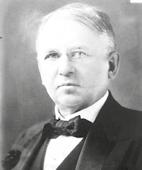
Until Mr. Wanamaker, a shopper would bargain for the wanted item. I was never one to bargain, but I remember so well my mother's gift of bartering. She loved to visit antique shops. "How much is this? No, I can only give you this amount!" I was always so embarrassed that I pretended I wasn't with her! She always insisted that antique shop owners loved to bargain!

Dallas Summer Musicals and at Casa Mañana and was head of the drama department at Dallas Baptist University for 12 years. Today she is on the speaking circuit and teaches drama classes at Providence Christian School. Her loving views of Texas history appear in every issue of
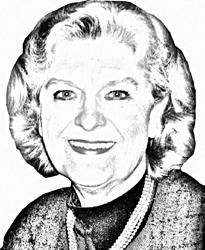

installed a grand and glorious court organ in his store on June 22, 1911the day of the coronation of George V of England. He was the first to have Christmas lights in his store and to have music played on the organ during the holiday season
The ‘other’ store, he built was Bethany Presbyterian Church, where thousands came to worship. He also supported the YMCA and wrote letters of encouragement to the members of his Sunday School Class. He raised the standard of living for all his employees.
As a young man, John Wanamaker always had a flair for big projects. He was a risk taker. Tired of being an errand boy, he got enough money together to buy an abandoned rail depot. He tried to get other merchants to open shops in the building, but when they didn't, he set up his own shops, thereby creating a department store!
His building had a wireless telegraph, so he was the first in the United States to hear of the sinking of the Titanic. And he was a leader in advertising and in employer benefits. Today, a statue of Wanamaker stands in front of the Philadelphia City Hall and the building that housed the original store is there - but today it is a Macy's!
Later, in 1924, he created the Macy’s Thanksgiving Day Parade which starts at Central Park and goes on down Broadway to Herald Square. Some years ago, my daughter was part of the Dazzlers, a dancing group in Dallas, who was asked to be in the Macy’s Parade. I, of course, went to New York to see her tap down Broadway. It was a cold day, but who cared!

The dancers gathered at Central Park and pranced down the famed White Way to Herald Square where the parade ended with much fanfare!
The movie, Miracle on 34th Street, was partially set at Macy's, starring Santa Claus. Macy's has a red star to tell of its great merchandise!
As a true Dallasite, I must tell the story of the legendary Neiman Marcus, famed store for wealthy Texans -and all of us that scrape up the money for the best!
When Stanley, Herbert's son, took over the operation, the store really came to the forefront. He was a genius at advertising. In 1939, he created a Christmas Catalogue that featured fantasy gifts. When one received the Neiman Marcus Christmas Catalogue, that person had it made financially.

The worst fire in Dallas was at Christmas time in1964. The sick joke of the day when someone sent you a card saying, "A fabulous gift has just been burned for you at Neiman Marcus."
Nevertheless, the store came back better than ever. Stanley also started what he called Fortnights. A country was selected for the two-week celebration. Art and clothing from that country would be featured along with their designers and artists. And of course, special food was offered at the Zodiac Room, the famed restaurant of the store.
There are many, many successful storekeepers in America; as we say, too many to mention. But every one of them is very aware of the trend in today's world – ‘online’ shopping. Delivery trucks have become more popular than malls!
Well, the price tag and the promise that if you didn't like the item your money was cheerfully refunded changed shopping. This assurance certainly increased sales in his expanding store, Oak Hall, which was later renamed Wannamaker’s, in downtown Philadelphia.

John Wanamaker was called ‘Pious John’, but that didn't bother him in the least. He was proud of the two ‘megachurches’ he built - one saved souls and the other sold clothes, jewelry, and perfume. He declared that business and religion were not in conflict. "The store is my pulpit!" He

Ah, there's a story– Mr. R. H. (Rowland Hussey) Macy!
As a young man, he sold goods to the mill workers in Massachusetts, but seeing a bigger buying public, he went to New York City and opened a store. Macy had terrific sales ideasfabulous window displays and not just Christmas music but Santa Claus himself! When he opened the store at Herald Square in 1907, he made big money immediately. The country was doing well financially, so shopping became a must.
When I graduated from high school, I insisted that my senior day dress and prom dress come from Neimans! My poor dear father took out a loan!
In 1907, Herbert Marcus and his sister, Carrie Neiman, opened this grand and glorious store. The city of Dallas was showing signs of wealth at the time, so the store made money right from the start. There were other fine department stores in Dallas, but Neiman Marcus gained fame as the grandest of all.
If you’d like to read more about "online" shopping, check out the new book, Fulfillment: Winning and Losing in One Click America by Mac Gillis. It's not the story of Jeff Bezos, CEO of Amazon, the richest person alive, but of what Amazon has done to neighborhoods and to the people who live in them. I was reading one review of this book, and there was an illustration to go with that review. Pictured was Grant Wood's American Gothicthe farmer, the wife, and the pitchfork. But, instead of the pastoral setting behind them, they were surrounded by Amazon/Prime boxes! n
- 48 - / THE NETWORK / MAY/JUNE 2021
I have the power to channel my imagination into ever-soaring levels of suspicion and paranoia.
éJohn Wanamaker
éHerbert Marcus é Carrie Nieman
éThe First Macy's Thanksgiving Day Parade
é R.H. Macy
it.
HANNIBAL HAMLIN
until DonalD trump, anDrew Johnson was widely considered by historians to have been the worst American president. He replaced Hannibal Hamlin on the Republican ticket for Lincoln’s second term run (in 1864) and served as vice president for just one month and one week before Lincoln was assassinated.
Hannibal Hamlin (1809 – 1891) was an American attorney and politician from Maine. In a public service career that spanned over 50 years, he became the 15th vice president of the United States, serving under Abraham Lincoln from 1861 to 1865. He was the first Republican to hold the office.

A native of Paris, Maine (which was part of Massachusetts until 1820), Hamlin managed his father's farm before becoming a newspaper editor. He studied law and was admitted to the bar in 1833. Originally a Democrat, Hamlin began his political career with election to the Maine House of Representatives in 1835 and an appointment to the military staff of the Governor of Maine. As an officer in the militia, he took part in the 1839 negotiations that helped end the Aroostook War.
The Aroostook War (sometimes called the Pork and Beans War) was a military and civilian-involved confrontation in 1838–1839 between the United States and the United Kingdom over the international boundary between the British colony of New Brunswick and the U.S. state of Maine. (“War’ is not an accurate way of describing this event. Militia units never engaged in actual combat; it is better described as an international incident.)
In the 1840s Hamlin was elected to in the United States House of Representatives. In 1848 he was elected to the United States Senate, where he

served until January 1857. He served temporarily as governor for six weeks in the beginning of 1857, after which he returned to the Senate. Hamlin was an active opponent of slavery; he supported the Wilmot Proviso (see related story on this page) and opposed the Compromise of 1850. In 1854, he strongly opposed passage of the Kansas–Nebraska Act. His increasingly anti-slavery views caused him to leave the Democratic Party for the newly formed Republican Party in 1856
In the 1860 election, Hamlin was the Republican nominee for Vice President. He was chosen in part to bring geographic balance to the ticket and in part because (as a former Democrat) he could work to convince other anti-slavery Democrats that their future was with the Republican Party. The Lincoln and Hamlin ticket was successful, and Hamlin served as Vice President from 1861 to 1865, which included all but the last month of the Civil War. Hamlin held the office in an era when the office was considered more a part of the legislative branch than the executive; he was not personally close to Lincoln and did not play a major role in his administration. Even so, Hamlin supported the administration's legislative program in his role as presiding officer of the Senate, and he looked for other ways to demonstrate his support for the Union, including a term of service in a Maine militia unit during the war.
For the 1864 election, Hamlin was replaced as Vice Presidential nominee by Andrew Johnson, a Southern Democrat chosen for his appeal to Southern Unionists. After leaving the vice presidency, Hamlin served as Collector of the Port of Boston, a lucrative post to which he was appointed by Johnson after the latter succeeded to the presidency following Lincoln's assassination. However, Hamlin later resigned as Collector because of his disagreement with Johnson over Reconstruction of the former Confederacy.
In 1869, Hamlin was elected again to the U.S. Senate, and he served two terms. After leaving the Senate in 1881, he served briefly as United States Ambassador to Spain before returning to Maine in late 1882. He died in 1891.
the wilmot proViso was an unsuccessful proposal in the United States Congress to ban slavery in territory acquired from Mexico in the Mexican–American War. The conflict over the Wilmot Proviso was one of the major events leading to the American Civil War. Pennsylvania Congressman David Wilmot introduced the proviso in the House of Representatives in 1846, as a rider on a $2,000,000 appropriations bill intended for the final negotiations to resolve the Mexican–American War (this was only three months into the two-year war). If successful, it would have effectively cancelled out the 1820 Missouri Compromise, since it would have prohibited slavery in an area where it had been permitted. It passed the House but failed in the Senate. It was reintroduced in February 1847 and again passed the House and failed in the Senate. In 1848, an attempt to make it part of the Treaty of Guadalupe Hidalgo also failed. Sectional political disputes over slavery in the Southwest continued until the Compromise of 1850.
The Compromise of 1850 was a package of five separate bills passed by the United States Congress in September 1850 that defused a political confrontation between slave and free states on the status of territories acquired in the Mexican–American War. It also set Texas's western and northern borders and included provisions addressing fugitive slaves and the slave trade. The compromise was brokered by Whig senator Henry Clay and Democratic Senator Stephen Douglas with the support of President Millard Fillmore.

The Kansas–Nebraska Act of 1854 created the territories of Kansas and Nebraska. It was drafted by Senator Stephen A. Douglas, passed by Congress, and signed into law by President Franklin Pierce. Douglas intended the bill to open up new lands to development and facilitate construction of a transcontinental railroad, but it is most notable for effectively repealing the Missouri Compromise, stoking national tensions over slavery, and contributing to a series of armed conflicts known as "Bleeding Kansas". n

- 49 - / THE NETWORK / MAY/JUNE 2021
Junk
something you’ve
throw away three weeks before
is
kept for years and
you need
é Hannibal Hamlin
é David Wilmot
Credit: Golbez. See Charles O. Paullin and John K. Wright Atlas of the Historical Geography of the United States (1932) for PD maps which support these. - Own work, CC BY 2.5
YOU NEED (OR MIGHT WANT) TO KNOW EGAL VIEW
ANTHONY J. BARBIERI ajb@kesslercollins.com

THE POWER OF EMINENT DOMAIN

when wooDy guthrie wrote the lyrics to the classic 1940’s American folk song, “This Land is Your Land”, I suspect he was not referring to the government’s power of eminent domain. But ask any landowner who has ever lost property via a government taking, and those lyrics probably describe their sentiment – albeit not the same sentiment Woody had in mind.
KELO – 2005
In the most famous recent eminent domain case, Kelo v. City of New London (Connecticut), the United States Supreme Court permitted the use of eminent domain power to transfer land from one private owner to another private owner to “further economic development.” In a 5–4 decision, the Court held that the general benefits a community enjoyed from economic growth qualified private redevelopment plans as a permissible “public use” under the Takings Clause of the Fifth Amendment to the United States Constitution.
The Kelo case caused a lot of public backlash. Many people – lawmakers, businesspeople, and legal scholars – viewed the outcome as a gross violation of property rights and as a misinterpretation of the U.S. Constitution, the consequence of which would be to benefit large corporations at the expense of individual homeowners and local communities. The public outcry was so loud that even then President George W. Bush issued an executive order instructing the federal government to restrict the use of eminent domain authority. In the aftermath, many states enacted ‘antiKelo’ legislation, and currently just about every state in America has a law on the books to prohibit a Kelo-like result in their jurisdiction.
EMINENT DOMAIN IN TEXAS

By comparison, the Texas Constitution long ago established that private property may only be taken by the government for public use. This concept has its origin in the Magna Carta and was
included in the Declaration of Rights of the Republic of Texas Constitution of 1836 and has been in every subsequent version of the Texas Constitution since. Even though eminent domain cannot be used for private purposes in Texas, there are still thousands of eminent domain cases here every year. None are as high profile as the Kelo case, but they can have great impact on the lives and wellbeing of those involved.
So what is eminent domain? What is condemnation? How does it work in Texas? Generally speaking, eminent domain is the government’s authority (or a private entity authorized by the government) to take private property for public use. “Condemnation” is the legal process by which the property is actually taken. (The process is governed by the Texas Property Code and the Rules of Civil Procedure.) However, the laws related to the power, and limitation, of eminentdomain authority exist in the state Constitution and various statutes. There are many statutes that grant and limit the power of eminent domain. For example, a section of the Local Government Code provides the basic statutory authority giving cities eminentdomain power. Various provisions of the Texas Education Code dictate how independent school districts and universities can exercise their power of eminent domain. There’s even a statute that allows a Texas school to condemn private property for a football stadium! Score! Further, the law allows for property to be taken via eminent domain for utility projects (e.g., gas pipelines, electrical lines,
water and sewer lines) and infrastructure projects (such as expanding highways, building roads and bridges).
Sometimes the condemning entity seeks to take the property owner’s entire parcel of land; other times, it just seeks a piece of the land or an easement – such as when a utility company wants to run pipelines underground or utility lines overhead. Regardless of the type of taking, the landowner has the right to receive “just and adequate compensation.” Both the Texas and the United States Constitution guarantee these rights, yet landowners often feel like they get the short end of the stick and that the government is only willing to pay a fraction of what the landowner might believe his property is worth.
THIS PROPERTY IS CONDEMNED!
Once a condemning authority decides to take your property via eminent domain, it is required by law to negotiate with landowners before judicial process begins. To satisfy this legal requirement, the condemning authority has to make a bona fide offer, which requires it to: (1) make an initial good faith offer in writing; (2) obtain a written appraisal from a certified appraiser of the value of the property being acquired – and the damages (loss of value) if any to the remainder property after the taking; (3) make a final written offer (along with a copy of the appraisal and the pro-
/ THE NETWORK / MAY/JUNE 2021 - 50 -
By the time you make ends meet, they move the ends.
Anthony J. Barbieri is a shareholder of Kessler Collins, PC in Dallas, Texas. He is a Fellow of the Litigation Counsel of America and a member of the State Bar of Texas, Dallas Bar Association and the American Bar Association. He is also a Contributing Editor of
posed deed, easement, or conveyance if these have not been previously provided) at least 30 days after the initial offer –which is equal to or greater than the value contained in the appraisal; and (4) give the property owner at least 14 days to respond to this final offer. The condemning authority must also send the landowner a copy of the “Landowner’s Bill of Rights”, a document prepared by the Texas’ Attorney General’s office that explains, in general, the landowner’s rights in the condemnation proceeding.
If those negotiations are unsuccessful –either because the two parties cannot agree on the price or the landowner doesn’t want to give up its property, the condemning authority can file a lawsuit in the county where the property is located. The judge must appoint three disinterested realproperty owners who reside in the county to serve as ‘special commissioners’; each party can strike (i.e., reject) one of the commissioners, in which case, the judge must appoint a replacement.
THE DETERMINATION OF VALUE
The special commissioners’ sole purpose is to assess the damages (appropriate compensation) to be paid to the owner for the value of the property being taken and, if applicable, the loss of value to the remaining property. The valuation must always consider the highest and best use of the property – both immediately and in the reasonably foreseeable future. After assessing the damages and allocating the costs, special commissioners prepare a written decision, called an “Award of Special Commissioners,” which is signed, dated and filed with the court.
Either side may object to the findings of the special commissioners by filing a written objection with the court. If no objections are filed, the decision is final. If objections are filed, the county (or district) court would try the case de novo. (A trial de novo is a proceeding in which the entire case is reconsidered.)
After the special commissioners have made their determination, the condemning authority can take possession of the condemned property pending the results of further litigation as long as it pays the property owner the damages and costs awarded by the commissioners, or deposits that amount of money is escrow with the court. If this occurs, and the court subsequently decides that the condemning authority did not have the right to condemn the property, the court will order the condemning authority to surrender possession and can also award the owner damages as a result of the temporary possession.
POSSESSION NOT OWNERSHIP
That nuance (allowing the condemning entity to possess the property while the trial court decides the case) of Texas law often frustrates Texas landowners. As does this nuance: there are very few successful defenses to a government entity’s ability to condemn a private landowner’s property for public use in Texas. Defenses do exist, such as the requirement that the condemning authority’s exercise of its eminent domain authority not involve any fraud, bad faith, or circumstances revealing arbitrary or capricious actions. However, the landowner’s burden of proving such a defense is quite high, and in Texas there have historically been very few cases where the

landowner succeeds in outright blocking the condemnation.
What is a landowner to do if faced with a condemnation? It is important to start early in the process and try and negotiate with the condemning authority; attempt to dissuade them from taking your property. If that doesn’t work (and it usually doesn’t), then (assuming of course that the condemning authority has proper legal authority), the name of the game for the landowner will be to get the best price it can get for the land –whether in the negotiation process, at the special commissioners’ court, or in the trial court. This will most certainly necessitate engaging competent legal counsel, as well as experienced expert witnesses that can testify about the value of the property and its highest and best use. If you don’t properly assert your rights, not only will you be serenading the government with your version of “this land is your land”, but you’ll likely be also singing that song with very little money in your pocket. n
Ed. Note: This piece originally appeared in the June 2014 issue of . Tony Barbieri’s article on tortious interference with contracts will appear in the next issue.
DIVERSI NS THE LIGHTER SIDE OF THE PANDEMIC – PART 9


The World Health Organization has announced that dogs cannot contract Covid-19. Dogs previously held in quarantine can now be released. To be clear… WHO let the dogs out.
It’s pretty wild how we used to eat cake after someone had blown on it... Good times!.
Due to my isolation. I finished three books yesterday… and, believe me, that’s a lot of coloring.

/ THE NETWORK / MAY/JUNE 2021 - 51The older we get, the fewer things seem worth waiting in line for.
ç On average, a panda feed for about 12 hours each day. This is the same as an adult human at home under quarantine – which is why it is called a “pandemic.”
çMasks are the new bra... They aren’t comfortable. You only wear them in public. People will notice when you don’t wear one. And now you can get them in every pattern and style.
"There is the kind of beauty seen with the eye and a kind of beauty seen with the heart in the meaning of things. My love for both kinds is the basis for the creation of my dramatic landscape paintings. With each brushstroke, my aim is to figuratively transport you into places that comfort, inspire, and enlighten your day.”
ARTCH TECTURE
CHUCK PINSON ARTIST OF INSPIRATION

chuck pinson's Dramatic lanDscape paintings are created to draw one into beautiful and imaginative places. Each scene offers a "daydream escape" to an idyllic place, far away from the stress and chaos life can bring. With a deep appreciation of the beauty surrounding us, Chuck approaches painting as a creative interpretation of that beauty, which he believes was created by God for our enjoyment and for our contemplation of what lies beyond the tangible world. He notes that one of the struggles most of us face are constant distractions that can often limit our appreciation and contemplation of such beauty.
He was raised along with his two brothers in the small town of King, North Carolina. The rural farmland and foothills to the Appalachians were an early inspiration to begin drawing and painting from a young age. He moved to West Texas in the late 1990s to attend Abilene Christian University, earning degrees in Christian missions and ministry before beginning his art career.
The realism genre has had a number of talented artists over the centuries who have influenced his style of painting. He is appreciative of those who have gone before; nonetheless, Chuck always seeks to paint his own unique visions. Through the use of multiple oil glazes, vibrant color, and painstaking detail, he endeavors to transport viewers to places where they can almost hear the water flowing and the birds chirping, feel the nostalgia in the air, or imagine walking through the

/ THE NETWORK / MAY/JUNE 2021 - 52Dyslexics of the world, untie!
01
garden, living in the dwelling, and conversing with friends along the town street. His art invites one to sit back, relax, and dream.


Through much work, perseverance, and providence, Chuck's professional art career began to take off in the mid-2010s. Many collectors from different countries own his artwork in the form of originals, canvases, and prints, while several other art-based products are also distributed around the world. His main goal has been to make art that is captivating, relaxing, and affordable for those who appreciate his imaginative visions and style. With the integral help and support of his wife, Deborah, he has experienced a successful and growing international brand and following. Chuck currently resides near Atlanta, Georgia with his wife and daughter.
To view many more of Chuck's paintings, visit chuckpinson.com n





For more of Chuck's paintings, visit: chuckpinson.com

WHY ARTCH TECTURE ?
Great art is among the most sublime, meaningful, and redeeming creations of all civilization. Few endeavors can equal the power of great artwork to capture aesthetic beauty, to move and inspire, to change perceptions, and to communicate the nature of human experience. Great art is also complex, mysterious, and challenging. Filled with symbolism, cultural and historical references, and often visionary imagery, great artworks oblige us to reckon with their many meanings.
Architects and designers (many of our readers) have a lot of influence on the way we perceive the world. A structure often plays a significant part in how we experience a place. (Think of a restaurant, a museum, an arena, a stadium... even an office building - virtually anywhere!) The interior design impacts our sensory perception, our comfort, and our physical connection and there is also artistry
why we call it artchitecture.)
- 53 - / THE NETWORK / MAY/JUNE 2021 Balderdash –a rapidly receding hairline.
the
(That’s
in
exterior design.
02 03 04 06 08 09 05 07 01/ Vibrance of Italy. 02/ Sea Garden Cottage. 03/ The Way It Used To Be. 04/ Cottage by the Sea. 05/ Faith Runs Deep. 06/ Sea BreezeTrail. 07/ A Beautiful Day at Cinque Terre. 08/ The Governor's Party. 09/ Space For Reflection.
THE RES URCE PAGE
ç Dr. Joseph G. Allen founded the Healthy Buildings Program at the Harvard T.H. Chan School of Public Health. His work centers around the belief that we must force a collision between two disciplines - building science and health science. One of the first goals of the program was to synthesize 30 years of public health science into identifying what it is that makes a building “healthy.” Those findings are summarized in the 9 Foundations of a Healthy Building report: Healthy Buildings. Last year, he also cowrote Healthy Buildings: How Indoor Spaces Drive Performance and Productivity (Harvard University Press; 2020) with John Macomber. Building on the mission of the Healthy Buildings Program, they combined their expertise in the fields of public health, urban resilience, commercial real estate, and building science to show the impact buildings have on our health and performance, and how every indoor environment can be made healthier for the people inside.
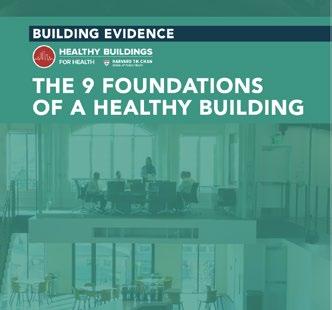
ç Applying econometrics in real estate development is not a simple task, as it involves a wide variety of complex tasks, critical goals, and data sources. But when used effectively, data science can help expand the margin of a professional’s experience by learning from data precedents across a market or sector. In this way, real estate developers can leverage historical data to develop better strategies and forecasts.
Data Science Strategies for Real Estate Development is a professional education course presented by the MIT Center for Real Estate, which says you will gain valuable insights into how to effectively implement data science approaches to solve pressing real estate development challenges. Led by real estate experts who regularly utilize econometric techniques, you will learn tested techniques, and expand your econometric knowledge by exploring applicable developments in data science, machine learning, and proptech ecosystem. Dr. Andrea Chegut PhD, the Director of the MIT Real Estate Innovation Lab, is the Lead Instructor; she has worked at the intersection of innovation, urban economics and real estate for over a decade. Learn more here.

DIVERSI NS MORE ACTUAL HEADLINES




Include Your Children when Baking Cookies
Something Went Wrong in Jet Crash, Expert Says Police Begin Campaign to Run Down Jaywalkers
Safety Experts Say School Bus Passengers Should Be Belted
Drunk Gets Nine Months in Violin Case
Survivor of Siamese Twins Joins Parents
Iraqi Head Seeks Arms
Prostitutes Appeal to Pope
Panda Mating Fails; Veterinarian Takes Over
British Left Waffles on Falkland Islands
Lung Cancer in Women Mushrooms
Eye Drops Off Shelf
Teachers Strike Idle Kids
Clinton Wins on Budget, But More Lies Ahead
Enraged Cow Injures Farmer With Ax
Plane Too Close to Ground, Crash Probe Told
Miners Refuse to Work after Death
Juvenile Court to Try Shooting Defendant
Stolen Painting Found by Tree
Two Sisters Reunited After 18 Years in Checkout Counter
Killer Sentenced to Die for Second Time in 10 Years
Never Withhold Herpes Infection from Loved One
War Dims Hope for Peace
If Strike Isn't Settled Quickly, It May Last a While
Cold Wave Linked to Temperatures
Deer Kill 17,000
Enfields Couple Slain; Police Suspect Homicide
Red Tape Holds Up New Bridges

Typhoon Rips Through Cemetery; Hundreds Dead
Man Struck By Lightning Faces Battery Charge
New Study of Obesity Looks for Larger Test Group
Astronaut Takes Blame for Gas in Spacecraft
Kids Make Nutritious Snacks
Chef Throws His Heart into Helping Feed Needy
Arson Suspect Held in Massachusetts Fire
Ban On Soliciting Dead in Trotwood
Local High School Dropouts Cut in Half
New Vaccine May Contain Rabies
Hospitals are Sued by 7 Foot Doctors
- 54 - / THE NETWORK / MAY/JUNE 2021
“I never forget a face, but in your case, I’ll be glad to make an exception.” (Groucho Marx)
A good time to keep your mouth shut is when you’re in deep water.
é with march being national Nutrition Month and obesity possibly tripling the risk of hospitalization due to COVID-19, the personal-finance website WalletHub released a report on 2021's Most Overweight and Obese Cities in the U.S., as well as accompanying videos. They compared 100 of the most populated U.S. metro areas across 19 key metrics ranging from the share of physically inactive adults to projected obesity rates by 2030 to healthy food access. The dubious achievement award goes to McAllen, TX which came in at #1 – the metro area has the highest share of obese adults, 44.9% (which is 2.4 times higher than in Asheville, North Carolina, the metro area with the lowest at 18.50%.)
é A new analysis by mortgage finance company Freddie Mac says that, as of the end of 2020, the U.S. housing market is 3.8 million single-family homes short of what is needed to meet current demand. This is a 52% increase since 2018, and (the housing deficit) explains the red-hot housing market. According to the Wall Street Journal, “The shortage poses an obstacle to U.S. economic growth, by pushing up housing prices and making difficult for first-time buyers to enter the market and build wealth.” There were 991,000 housing starts last year – the most since 2007, but homebuilders will have to construct 1.1 – 1.2 million single-family homes each year to keep up with demand and even more to cut into the current deficit. n

DIVERSI NS I HATE MEN – Q & A

Q. What do you call a handcuffed man?
A. Trustworthy.
Q. What does it mean when a man is in your bed gasping for breath and calling your name?
A. You didn't hold the pillow down long enough.
Q. Why do only 10% of men make it to heaven?
A. Because if they all went, it would be hell.
Q. Why do men like smart women? A. Opposites attract.
Q. How are husbands like lawn mowers? A. They're hard to get started, they emit noxious odors, and half the time they don't work.
Q. How can you tell when a man is well hung?
A. When you can just barely slip your finger in between his neck and the noose.
Q. How do men define a ‘50/50’ relationship?
A. We cook-they eat; we dean-they dirty; we ironthey wrinkle.
Q. How do men exercise on the beach? A. By sucking in their stomachs every time they see a bikini.
Q. How do you get a man to stop biting his nails?
A. Make him wear shoes.
Q. How does a man show he's planning for the future? A. He buys two cases of beer instead of one.
Q. How is Colonel Sanders like the typical male?

A. All he's concerned with is legs, breasts and thighs.
Q. How many men does it take to screw in a light bulb? A. One. He just holds it up there and waits for the world to revolve around him.
Q. What did God say after creating man?
A. I can do so much better.
Q. What do most men consider a gourmet restaurant? A. Any place without a drive-up window.
Q. What do you call a man with half a brain?
A. Gifted.
Q. What do you do with a bachelor who thinks he's God's gift to women? A. Exchange him.
Q. What should you give a man who has everything?
A. A woman to show him how to work it.
Q. What's a man's idea of honesty in a relationship?
A. Telling you his real name.
Q. What's the best way to force a man to do sit ups?
A. Put the remote control between his toes.
Q. What's the difference between Big Foot and an intelligent man? A. Big Foot's been spotted several times.
Q. What's the smartest thing a man can say?
A. "My wife says...”
Q. Why are all dumb blonde jokes one liners?
A. So men can understand them.
Q. Why did God create man before woman?
A. Because you're always supposed to have a rough draft before creating your masterpiece.
Q. Why do female black widow spiders kill the males after mating? A. To stop the snoring before it starts.
Q. Why do jocks play on artificial turf?
A. To keep them from grazing.
Q. Why do men need instant replay on TV sports?
A. Because after 30 seconds they forget what happened.
Q. Why does it take 100 million sperm to fertilize one egg? A. Because not one will stop and ask for directions.
Q. Why is it difficult to find men who are sensitive, caring and good looking? A. They all already have boyfriends.
Q. Why is psychoanalysis a lot quicker for men than for women? A. When it’s time to go back to his childhood, he's already there.
/ THE NETWORK / MAY/JUNE 2021 - 55 -
IN THE N WS
YOU NEED (OR MIGHT WANT) TO KNOW PROFESSIONALS ON THE
JULIE BRAND LYNCH
julie@LYNOUS.com
Julie Lynch is the principal of LYNOUS, a talent management firm that provides recruiting, interim staffing and training to the real estate industry. She is also a contributing editor of


01/ Kevin Butkus was promoted to vice president with the Dallas-Fort Worth office of Weitzman.
02/ Matt Silvers joined Project Management Advisors in Austin.





03/ Jackie Rye was promoted to Market Principal in the Houston office of Method Architecture.



04/ Kristen McDade joined Cushman & Wakefield’s Houston office and will specialize in the land market.
05/ Matthew Davis joined Cushman & Wakefield’s Houston office and will specialize in the land market.
06/ Erik Hill, MAI was promoted to National Practice Leader of JLL’s Valuation Advisory Group. He will be based in Dallas.





07/ Cherolyn Johnson Chiang joined The Jenkins organization as Director of Marketing in Houston.

08/ Traci Li joined SVN | Dunn Commercial Services as an investment advisor in DFW.

09/ Stephen Wise was promoted to Vice President in the DFW office of Weitzman.


10/ Amy Grueso was promoted to Assistant Vice President at Weitzman in DFW.

11/ Brian Riazzi joined Colliers in Austin as an Associate Vice President.



12/ Brad Hauser joined Transwestern in Houston as Vice President of Research & Analytics.

13/ Jeremy Rollwitz was promoted to Regional Manager at The Jenkins Organization in Houston.


14/ Amanda Dickson was promoted to District Manager at The Jenkins Organization in Houston.
15/ Clint Bawcom was named Managing Principal of Cushman & Wakefield’s Houston office.
16/ Russell Hodges joined CBRE’s Advisory & Transaction Services business in Houston as an Executive Vice President.
17/ Bubba Harkins joined CBRE’s Advisory & Transaction Services business in Houston as Executive Vice President.
18/ Jessica Ochoa joined CBRE’s Advisory & Transaction Services business in Houston as a Senior Vice president.
19/ Derek Schuster was promoted to Vice President at the DFW office of Weitzman.
20/ Daniel Taylor joined Colliers as Executive Managing Director and Market Leader for Brokerage in DFW.
21/ Mansoor Ghori joined the board of directors of STG Design in Austin.

22/ Renee Kaiser joined Belvoir Real Estate Group, LLC as a Leasing Associate in Houston.


23/ Steve Bassett joined Foundry Commercial as Texas Market Leader with a focus on Dallas.

24/ David P. Hudson joined Griffin Partners Development in Houston as President.


25/ Joe Burke joined the land-focused brokerage group of NewQuest Properties in Houston as Vice President.
26/ Charles McGahren joined the land-focused brokerage group of NewQuest Properties in Houston as Associate.
27/ Travis Waltmon joined the land-focused brokerage group of NewQuest Properties in Houston as Senior Associate.

28/ Ashlee Owens, RID, NCIDQ joined Goree Interiors as a project manager.




29/ Rey Roca joined McKissack & McKissack as VP and Texas Regional Leader.

30/ Neal Golden was named president of Rastegar Property Company in Austin.


31/ Corbin Janssen joined Bryant + Stacy Group in Houston as vice president.

32/ Steven Benton was promoted to Chief Financial Officer at HPI in Austin.
33/ Colleen Lefebvre joined Sidecar Commercial Real Estate as a Senior Associate in Fort Worth.
34/ Rhett Meadows was promoted
to Regional Director of Sales at Hartman Income REIT Management.
35/ Cynthia Cowen joined Cushman & Wakefield as Managing Director of the Office Agency Leasing team in Dallas.
36/ Evan Saks joined Transwestern Real Estate Services’ Healthcare Advisory team in Dallas as Vice President.
37/ Laura Lea joined Transwestern Real Estate Services’Healthcare Advisory team in Dallas as Vice President.
38/ Bob Krass joined Transwestern Real Estate Services’Healthcare Advisory team in Dallas as Associate.
39/ Travis Rodgers was promoted to partner and Chief Operating Officer at NAI Partners.
40/ JLL’s Houston office added a large tenant representation team (formerly with CBRE) including (L-R) Paul Penland, Steve Hesse, Bentley Scott, Brandon Clarke, James Robertson, Kendall Hughes, Jeff Cairns, Sanford Criner, Mark Reilly, Graham Horton, Rachel Hinton, Matt Trozzo, Charles Gordon, Josh O’Rear, Harrison Yang and Ryan Roth. n

- 56 - / THE NETWORK / MAY/JUNE 2021 Stupidity got us into this mess. Why can’t it get us out?
Did you recently take a step in your career? We want to know! editor@crestnetwork.com 01 23 12 34 37 07 29 18 03 25 14 36 39 05 27 16 11 33 22 02 24 13 35 38 08 30 19 04 26 15 09 31 20 10 32 21 06 28 17
40
I FEEL LIKE AN IDIOM


An idiom is a group of words established by usage as having a meaning not deducible from those of the individual words (e.g., rain cats and dogs, see the light). Sometimes they are just short pithy saying stating a general truth or piece of advice. (Yes! We said pithy!) Here are some sayings (adages, proverbs, idioms) that have been reworded to remove the pith (so to speak). They’re no longer concise, for sure. Can you interpret the phrases so as to figure the well-known proverbs they represent? (The answers are on the back page.)



“Be careful about reading health books. You may die of a misprint.” (Mark Twain)
1. All articles that coruscate with resplendence are not truly auriferous.
2. Sorting on the part of mendicants must be interdicted.
3 Male cadavers are incapable of rendering any testimony.
4. Neophyte’s serendipity.
7. Pulchritude possesses solely cutaneous profundity.
8. Freedom from incrustations of crime is proximal to rectitude.


9. It is fruitless to become lachrymose of precipitately departed lacteal fluid.
10. Eschew the implement of correction and vitiate the scion.
11.The stylus is more potent than the rapier.

12. It is fruitless to attempt to indoctrinate a superannuated canine with innovative maneuvers.
13 Surveillance should precede saltation.
14. Scintillate, scintillate, asteroid minim.
15. The person presenting the ultimate cachinnation possesses thereby the optimal cachinnation.
16. Exclusive dedication to necessitous chores without interludes of hedonistic diversion renders Jack a hebetudinous fellow.
17. Individuals who make their abodes in vitreous edifices would be advised to refrain from catapulting petrous projectiles.
18. Where there are visible vapors having their provenance in ignited carbonaceous materials, there is conflagration.
19. No remittance is given for actions which are taken counter to the codified body of juris prudence. n
/ THE NETWORK / MAY/JUNE 2021 - 57 -
5. A revolving lithic conglomerate accumulates no congeries of small, green, biophytic plant.
6. Members of an avian species of identical plumage tend to congregate.
“I have a daughter who goes to SMU. She could’ve gone to UCLA, but it’s one more letter she’d have to remember.” (Shecky Greene)

/ THE NETWORK / MAY/JUNE 2021 - 58 -
the trust for public lanD works to protect the places people care about and to create closeto-home parks — particularly in and near cities, where 80 percent of Americans live. Its goal is to ensure that every child has easy access to a safe place to play in nature. They also conserve working farms, ranches, and forests; lands of historical and cultural importance; rivers, streams, coasts, and watersheds; and other special places where people can experience nature close at hand.
Founded in 1972 with the goal of protecting land in and around cities and pioneering new land conservation techniques, its work has expanded to include projects from the inner city to the wilderness. In cities, they’re turning vacant lots into community-designed parks and playgrounds. And we’re addressing the looming climate crisis with strategies to help reduce greenhouse gasses, promote climate adaptation, and create park-rich, climatesmart cities.
The Trust for Public Land’s ParkScore® index is the most comprehensive tool available for evaluating park access and quality in the 100 largest U.S. cities. With the permission of and thanks to The Trust for Public Land, this is the last of fourteen installments of the results of that study. Please see our archived editions at www.crestnetwork.com for other Texas cities – or, if you want to see where your (or another) city rates, go to: www.tpl.org/node/110916 n

/ THE NETWORK / MAY/JUNE 2021 - 59 -
We provide you with an extraordinarily clean, allergy free environment. Our specialists thoroughly clean your carpets, tile, wood, or concrete with superior, green solutions.


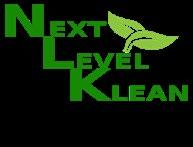


PAVINGS:






/ THE NETWORK / MAY/JUNE 2021 - 60MADE YOU LOOK! Our readers are your customers! According to the The Nielsen Company, Benchmarking Return on Ad Spend: Media Type and Brand Size Matter, magazines remain one the most trusted forms of advertising! YOU NEED (OR MIGHT WANT) TO KNOW
:
AND DIRECTORY EXECUTIVE SEARCH, INTERIM PLACEMENTS & TRAINING: EXTERIOR WALL CONSULTING: JANITORIAL SERVICES: CARPET CLEANING: LEGAL: 214.991.2988 Commercial Floorcare Specialist www NextLevelKlean com
LINK
MARKET PLACE
Jason Cox Jason@NextLevelKlean.com










/ THE NETWORK / MAY/JUNE 2021 - 61SAFETY PRODUCTS: REACH YOUR FOR LESS Links listings require a 4-issue (non-cancellable) commitment 1” Full Color ad .............. $148 per issue 2” Full Color ad .............. $207 per issue 3” Full Color ad .............. $295 per issue PAVINGS: “Make Every Step a Safe One” Wooster Products Inc. Anti-slip safety stair treads & walkway products sales@wooster-products.com www.woosterproducts.com 800-321-4936 PROUDLY MADE IN THE USA Stairmaster ® Type 511 Flexmaster ® Type 311 BE BETTER. BE REAL. www.narwhallife.com
THE BACK PAGE
ANSWERS FROM THE MARCH/APRIL CONTEST – UP, UP AND AWAY


ANSWERS FROM PAGE 57: I FEEL LIKE AN IDIOM
1. All that glitters is not gold.
2. Beggars can’t be choosers.
3. Dead men tell no tales.
4. Beginner's luck.
5. A rolling stone gathers no moss.
6. Birds of a feather flock together.
7. Beauty is only skin-deep.
8. Cleanliness is next to Godliness.
9. There's no sense crying over spilt milk.
10. Spare the rod and spoil the child.
11. The pen is mightier than the sword.
12. You can’t’ teach an old dog new tricks.
13. Look before you leap.

14. Twinkle twinkle little star.
15. He who laughs last, laughs best.
16. All work and no play make Jack a dull boy.
17. People who live glass houses shouldn’t throw stones.
18. Where there’s smoke, there’s fire.
19. Crime doesn't pay.
CONGRATULATIONS TO ALL OF OUR CONTEST WINNERS!
Eva Savino of McAllen, TX won a copy of Saving Capitalism.
Dina Reinhart of Austin, TX won Cablelinx from Limitless Innovations

Ellen Graeber of New York, NY won a Brydge wireless keyboard
Tarim Riggler of Atlanta, GA won a Kinivo min speaker
Kevin Cafferty of Beaumont, TX won a copy of Rethinking Real Estate
Brandon Minskoff of Tulsa, OK won a copy of Sufficiency Thinking
BOLO (BE ON THE LOOK OUT) FOR WHAT'S COMING NEXT
In Herstory, Contributing Editor RoseMary Rumbley looks at Texas’s excellent painters and sculptors- Jonathan Borofsky, Allie Victoria Tennant, Frank Reaugh, J. Onderdock and Elizabeth Ney. Contributing Editor Angela O’Byrne’s Amazing Buildings will examine two buildings that make beautiful use of intricate symbols on their exterior: the Sunac Guangzhou Grand Theatre and the Museum of the Future in Dubai.
Contributing Editor Tony Barbieri’s Legal View will examine legal issues involving tortious interference with contracts. And
Contributing Editor Roxana Tofan’ Profiles of Survival will look at Lone Star Capital Bank and how it is faring through the pandemic. We’ll continue our look at the architectural treasures of American cities, this time of San Francisco and we’ll do the same for one of its Sister Cities –Barcelona, Spain
In You Need (or might want) to Know, we’ll take a look some interesting words and concepts. For example, what is a precinct? What is a ward? Why do rifles have magazines? And, in words and pictures, we’ll look at the architecture of two
out-standing world-class architectural firms. (That’s all were saying for now. J)
Specially contributed articles from various industry segments will continue to discuss issues presented by COVID-19 and, of course, we will have our affiliates’ awards and special events, The Wow Factor, Diversions, By the Numbers, True Dat, The History Page, Political Corner, Professionals on the Move, The Resource Page, Shout-Outs, Real Estate of the Future, and much MUCH more. We get a lot into 64 pages!

- 62 - / THE NETWORK / MAY/JUNE 2021
1. ACA 2. AMA 3. BWI 4. PEK 5. MCI 6. LAX 7. ICT 8. CPH 9. ELP 10. YMQ 11. YQB 12. UIO 13. SJT 14. SPS 15. ORD 16. CUU 17. SFO 18. CRP 19. ZJK 20. EYW 21. BNA 22. SRQ 23. ACT 24. LAS 25. CVG
INDEX TO OUR ADVERTISERS Anderson Paving 13, 60 www.andersonpaving.com Arsenal Companies, The Back Cover www.thearsenalcompanies.com Construction Consulting International 60 www.sunited.com Crest Publications Group 3, 7, 9 www.crestpublicationsgroup.com Image Building Maintenance 9, 60 www.imagebuildingmaintenance.com Kessler Collins ...................................................................... 60 www.kesslercollins.com Kyocera 15 www.kyoceranevill.com Lynous Turnkey Solutions 60 www.lynous.com Master Construction & Engineering 60 www.masterconstruction.com Narwahl 61 www.masterconstruction.com Next Level Klean ........................................................ 19, 60 www.nextlevelklean.com Recycle Across America 14 www.recycleacrossamerica.org Pave-It 45 www.paveitdfw.com Reliable Paving 2, 61 www.reliablepaving.com Wooster Products .................................................... 23, 61 www.woosterproducts.com
C NTEST: WHAT KIND OF LEADER DOES THAT COUNTRY HAVE, BWANA?










Different forms of goVernments have different names for their leaders (or rulers). In some cases (actually in most cases) that can be confusing to outsiders because the head of state is not the same as the head of government. The United Nations.recognizes 197 countries in the world, four of which (Taiwan, Vatican City, Kosovo, Palestine) are not members; and in less than a third of them is the head of state and the head of government the same person. What’s more, there are many countries that have a prime minister and a president or a king or even a supreme leader and a president. And many titles for leaders and rulers which were used historically and are of less frequent use today, a lower status of leadership in many country’s hierarchies, or not even in current use. Think Chief, Tsar (czar), Viceroy, Shah, Raja, or Governor-General - just to name a few.

You’ll recognize some of the people in these pictures. In other cases, you may not even recognize the name of the country. But if you really want to win…write the letter of the leader or ruler’s title in the space provided.



Then, scan or copy this page and send your entry to editor@crestnetwork.com or fax it to 817.924.7116 on or before May 28th for a chance to win a valuable prize. (The answers will appear in our July/August issue, but if you can’t wait and want to make sure all of your answers are correct, go to: en.wikipedia.org/wiki/List_of_current_heads_of_state_and_ government.)

/ THE NETWORK / MAY/JUNE 2021 - 63 -
01/ Qatar: 02/ Brunei: 03/ United States: 04/ United Kingdom: 05/ Japan:
06/ North Korea: 07/ Islamic State of Iraq and the Levant: 08/ Luxembourg: 09/ Sweden: 10/ Vatican:
11/ Denmark: 12/ Monaco: 13/ Malasia: 14/ Samoa: 15/ Austria:
é Sheikh Tamim bin Hamad Al Thani
é Hassanal Bolkiah
é Abu Ibrahim al-Hashimi al-Qurashi
é Albert II (Albert Alexandre Louis Pierre Grimaldi
é Kim Jong-un
é Margrethe II
é Joseph R. Biden
é Henri Albert Gabriel Félix Marie Guillaume
é Al-Sultan Abdullah Ri'ayatuddin Al-Mustafa Billah Shah
é Boris Johnson
é Carl XVI Gustaf
é Tuimalealiifano Va'aleto'a Eti Sualauvi II
é Naruhito
é Francis (Jorge Mario Bergoglio)
A E I M C G K O B F J N D H L
é Sebastian Kurz
...BECAUSE SOMETIMES IS WHAT
We Speak Real Estate
The Arsenal Companies are a diversified consulting, educational and publishing group, dedicated to service in the real estate industry. With national reach, regional strength and local sensibilities, we serve and service large and small companies as well as governmental entities in acquisitions, dispositions, leasing, licensing, contracting, procurement, insurance certificate tracking, educational program development, mediation services and collections.
Our Contracts and Procurement Services Division provides solutions and services that help real estate owners and companies effectively manage their contractual needs and commitments. We provide industry knowledge and we practice deal facilitation rather than obstruction. Whether you are a property, facility or asset manager, your functions are integrally related to real estate contracts. Quality management is all about contracts.
Leasing
Acquisitions, dispositions, renewals, surrenders, amendments, abstracting, administration, interpretation – our professionals are experienced in residential, commercial, industrial, professional and retail leasing issues of all kinds.

YOU KNOW
Anyone with experience.
Don’t assume that problems won’t occur. Plan what you can do to avoid them. A small reduction in costs can be the equivalent of a substantial increase in value. We suggest ‘refinements’ to improve language and reduce direct and indirect costs. Our attorneys have successfully resolved leasing issues for both small and Fortune 100 corporations – effectuating $millions in savings.
Procurement
Supply Chain Management
Procurement Administration
Supplier Recognition Programs
RFI, RFP, RFQ Administration
Vendor/Supplier Resourcing
Vendor Reduction Programs
Customized Purchase Orders
Are the contracts for services and supplies which your organization uses prepared for your organization – or are they the vendor’s or contractor’s agreement forms? Wouldn’t you be better off if those agreements and purchase orders were revisited from your perspective? Isn’t it time you fortified your real estate related contracts?
Contract Negotiation and Drafting Services


Do you have contract issues that call out for review, interpretation and the advice of a specialist? Do you have a service contract which is about to expire and will need to be renewed or replaced? Do you have oversight of a real estate or facilities function which has been given savings targets? Have you considered ‘outsourcing’ this part of your real estate function but fear a loss of control?
We analyze the details of your proposed service contracts before they begin - while you still have leverage. Or, we can review your existing service contracts, help reveal cost efficiencies and/or savings opportunities. We look for pragmatic solutions that are sensitive to your business interests, anticipating issues that may arise, and we assist in minimizing those risks that cannot be avoided.
- 64 - / THE NETWORK / MAY/JUNE 2021 Aa The Arsenal Companies 2537 Lubbock Avenue Fort Worth, TX 76109 Tel: 682.224.5855 Fax: 817.924.7116 www.thearsenalcompanies.com
Highly focused.
specialized.
respected.
Highly
Highly
Leases are highly specialized documents. A few words can make a world of difference.
ARSENAL BUSINESS COLLECTIONS








































































































































































































































































































































































































